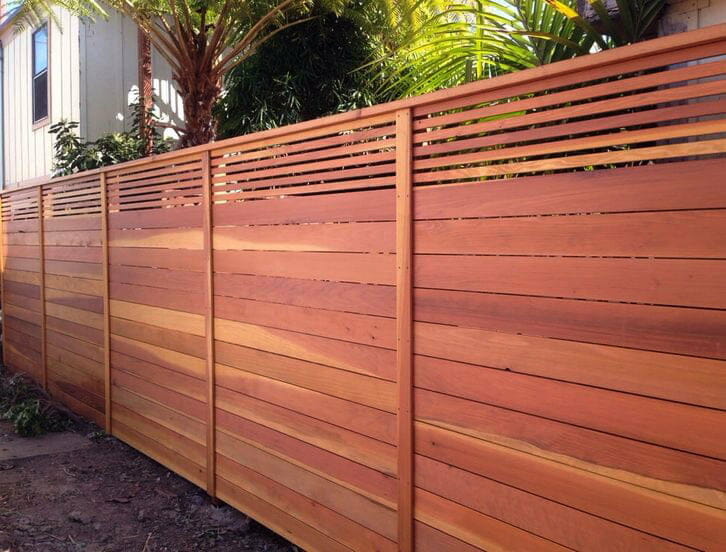Redwood is widely considered one of the best options for wooden fencing due to its exquisite color, durability, and natural resistance to rot, insects, and warping. It is frequently used for both home exteriors and building decks. If you are looking for a strong and aesthetically pleasing fence, redwood is an excellent choice.
On average, homeowners spend about $2,812.50 to install redwood fencing. The real range is between $1,575 and $4,050. The cost to install the fence per linear foot averages from $15 to $40.
The actual installation cost of redwood fencing will depend on the size of the project, difficulty of the job, location, and finish options.
The cost of redwood fencing
This table provides you with the national average cost to install redwood fencing.
| Cost per linear foot | $15 - $40 |
|---|---|
| National Average Cost | $2,812.50 |
| Average Labour cost | $8 - $25 |
| Cost of materials only | $7 - $15 |
Redwood fencing cost per linear foot
The average cost to install redwood fencing per linear foot is about $18 to $40. This cost varies widely depending on the size of the project, your location, and the job’s complexity. The average cost for redwood fencing per foot is $31.35. You can pay about $18 per linear foot for smaller and straightforward projects, while larger and more complicated projects can be up to $45 per linear foot.
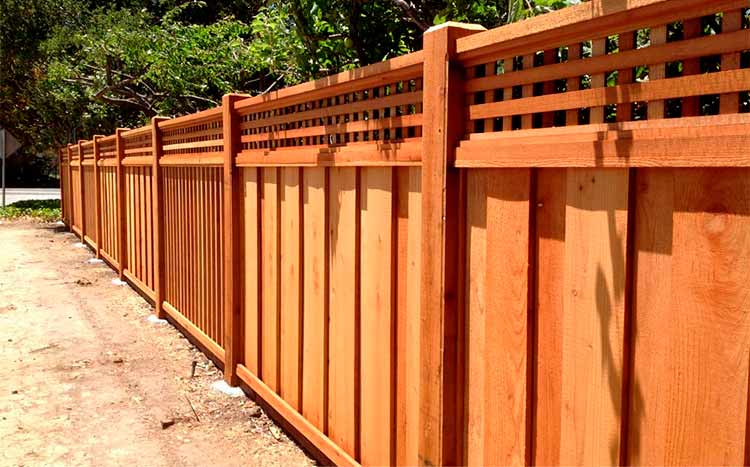
National average cost of redwood fencing
The national average cost to install redwood fencing is in the vicinity of $2,812.50, coming in between $1,575 and $4,050. On the low end, the cost averages at $800, while the high end can go up to $6,500.
Average labour cost of redwood fencing
On average, labour cost for installing redwood fencing averages $8 to $25 per linear foot. The labour cost may, however, vary due to regional differences. Typically, high-income areas tend to pay more for labour than lower-income areas for a similar project.
Redwood fencing cost by style
Below is the average cost to install redwood fencing by style
| Style | Cost per linear foot |
|---|---|
| Picture frame board-on-board | $17.45 - $27.05 |
| Picture frame louvered frame | $15 - $25 |
| Jumbo lattice fence | $17 - $29.5 |
| Privacy lattice fence | $27 - $60 |
| Piano key lattice | $18.45 - $24.50 |
| Shadow-box | $12.5 - $19 |
| Nail-on flat fence | $10 - $15 |
Picture frame board-on-board
The picture frame board on board fence is perfect for people looking for privacy and aesthetics. This fence is highly attractive and keeps your property protected from snooping passers-by and stray dogs. This fence style is also very durable as it is constructed using thick redwood boards that do not warp easily.
The picture frame board on board fence is available in three redwood grades, so you can select the grade that fits your budget. Installing this fence will set you back by about $17.45 to $27.05 per linear foot.
Picture frame louvered frame
Another excellent redwood fencing style is the picture frame louvered frame fence. This is a neighbour-friendly fence that is also strong and secure. It provides optimal privacy and keeps you and your neighbours happy at all times. If you are looking for an appealing fence that will offer privacy for several years, this will make an excellent choice.
Be ready to spend approximately $15 to $25 per linear foot if you wish to install this fence style.

Jumbo lattice fence
The jumbo lattice redwood fencing style is another perfect choice for your home. This fence is constructed using the thickest, top-grade lattice in the industry. It is, therefore, one of the strongest fences that will offer you many years of seamless service. This fence style is also attractive and offers beauty and privacy. It helps keep your kids and pets within the compound and keep off prying people and unfriendly animals.
Installing this fence costs between $17 and $29.5 per linear foot.
Privacy lattice fence
If you want total privacy and security, the privacy lattice fence is for you. This fence is made using thick, standard handmade jumbo lattice to add an extra dimension. The privacy lattice fence features three layers that keep off prying people and unwanted animals from your yard. Get that custom look for your home without compromising quality and privacy with this fence style.
Expect to spend about $27 to $60 per linear foot to install this fence.
Piano key lattice
Here is another perfect fencing option for privacy and security. The piano key lattice fence is a picture frame fence family descendant. It is a custom fence that separates your fence from that of your neighbors. This fence style is designed using 2 x 2 redwood toppers. Small spaces are then incorporated in between every piece to keep the fence all vertical and horizontal.
The average cost to install this fence is around $18.45 to $24.50 per linear foot.
Shadow-box
The shadow box fence style is another excellent choice for your home. It is a cute style that adds beauty and quality to your property. This fence style is ideal for windy areas due to its open boards. It offers excellent privacy and security as it keeps prying eyes and stray dogs off while keeping your animals and kids safe in the compound.
This kind of fence costs around $12.5 to $19 per linear foot to install.
Nail-on flat fence
If you are looking for a quality fence on a budget, the nail-on-top fence is an excellent choice. It is an economical fence that offers simplicity and strength without compromising on quality. The nail-on flat top fence features a flat top look that makes it appealing. This fence offers durability and ensures you get the privacy you need for years.
Installing this fence style will set you back by approximately $10 to $15 per linear foot.
Is Redwood Good for Fencing?
Redwood is one of the most sought-after fencing materials because of its appearance and durability. But do these qualities make it good enough for fencing?
Yes, redwood is good for fencing. Thanks to tannins and other oils in the wood, it can resist rotting, moisture infiltration, and termite attacks. It has a beautiful color that is awesomely attractive. Also, it doesn’t warp or split as easily as other wood options. All of these things combined make it a good fencing material.
Here is everything that you need to know about redwood fencing.
What makes redwood good for fencing?
Redwood has several qualities that make it good for fencing. Here are the ones that stand out;
Beautiful – Redwood has a deep reddish color that is incredibly attractive. What is even better is that you don’t have to do anything to get it to be attractive. It is naturally beautiful, and using it will positively affect the aesthetic value of your home.
Durable – Redwood can easily last up to 25 years. With proper maintenance, it can last for over 30 years. This makes it a long-lasting fencing solution.
The durability of redwood makes it a superior fencing option when compared to other wood alternatives like cedar and pine.
Low maintenance – Redwood has a compact grain profile. It is dense. It also has oils and tannins that help to shield it against the negative effects of changing weather.
Since it already has an elaborate self-defense system against the elements, redwood doesn’t need much help.
Termite resistant – The oils in the wood are termite repellent. This goes a long way towards discouraging termites from attacking the tree. And it makes it possible for you to even install your fence to the ground.
This means that with a redwood fence, you won’t have to worry about premature repairs and replacements often occasioned by termite infestations.
Resistant to rotting – While treating a redwood fence will improve its resistance to rotting, it is not necessary.
It only enhances its resistance since the wood is already rot-resistant. And since rotting is a major problem for wooden fences, this quality gives it an edge over other wooden fence options.
When is redwood not ideal for fencing?
Redwood is not the best material for fencing in the following circumstances.
When you have a limited budget – At $25 – $50 per linear foot, redwood is pricier than other comparable types of wood like cedar. As a result, you should only opt for it as a fencing material if you have a large enough budget to support the extra costs.
Long or tall fences – Even when you have the budget for it, there is a point where a fencing project is just too big to use redwood as the primary material. Why? Because it will be too uneconomical to do so.
Is redwood fencing hard to maintain?
Redwood fencing is one of the strongest and most durable wood fences in the industry. It is naturally resistant to insects and decay, which makes it easy to maintain. Below are five key ways to properly maintain your redwood fence.
- Remove debris regularly and clean the fence at least once a year
- Inspect the fence from time to time and repair it on time to maintain its integrity
- Replace loose boards immediately to keep the fence firm and beautiful at all times
- Use a high-quality protective seal to protect your fence from the elements
- Keep your fence away from sprinklers and clear from vines
With regular maintenance, your redwood fencing will serve you for a long time and keep your property safe from intruders.
How long does redwood fencing last?
Redwood fencing lasts for up to 25 years with proper care and maintenance. If you clean the fence and repair it on time, it can last for a longer time. Yearly inspections are necessary to ensure the fence is in good condition.
DIY vs. Hiring a Professional
Fence installation is a demanding job requiring a skilled professional to handle the power tools properly and pour concrete correctly. An average homeowner may not have enough skills or access to the tools needed for the project. Hiring a professional fencing contractor can save you lots of time and money in the long term.
Do It Yourself
Pros
- DIY fence installations will save you lots of money
- You will have an excellent chance to sharpen your skills
- You will choose the fence style and grade you want
- The satisfaction that comes after completing the project is incomparable
Cons
- You will need to buy all the material and supplies needed for the project
- The job may take too long to complete
- You may expose yourself to harm due to inexperience
- DIY installations may be expensive in the long term due to frequent repairs caused by substandard installations
Hiring a Professional
Pros
- Pros have enough experience and expertise to install fences, so you will get high-quality installations
- The installation will be completed on time
- Professional installations are cheaper in the long run due to fewer repairs and material wastage
- Pros will come with their own materials and supplies
Cons
- Professional installations are quite expensive
- There is no assurance that the job will be good
FAQ's
Yes, you should seal your redwood fence after every 3-5 years. The stain will protect the wood from weather elements and enhance its durability. It also enhances the natural colour of the redwood. High-quality stains such as Preserva Wood offer excellent UV protection. This stain is also water repellent to protect your redwood fence from rainwater.
While a redwood fence itself may not add much value to a property, it will enhance a home’s value by up to 50% of the material cost if there is a true need for it. The quality of the materials used to install the fence also play a big role in increasing the value of a home. Installing a fence in the front yard, however, tends to reduce a home’s curb appeal. That is why most people prefer leaving their front yards exposed but fence the backyard.
Yes! Redwood is an excellent choice for fencing because it has a natural resistance to decay, rot, insects, and warping. It is a high-end wood fencing option that is cheaper to install than tropical woods. More so, it is naturally beautiful and long-lasting and can last for 25 years or more with proper care and maintenance.
Yes, redwood lasts longer than cedarwood. Both redwood and cedar are excellent options for residential fencing. However, redwood is stronger than cedar by approximately 23%, which makes it more durable. Redwood possesses more naturally occurring chemicals than cedarwood. The chemicals protect the wood from the weather, resulting in less maintenance over time.
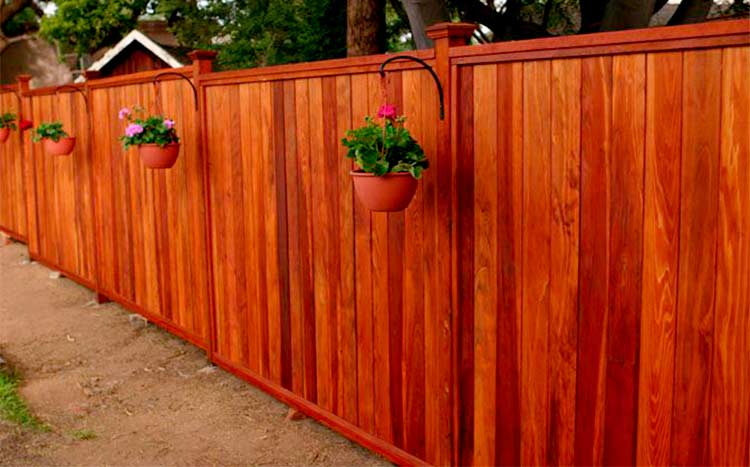
Several reasons exist for installing a welded wire fence, including the desire to enhance the security of your premises, keep predators out of your garden, or protect your property from unauthorized entry and intruders.
The average cost for a welded wire fence can fall between $4 to $10. The cost can vary depending on the gauge size, the thickness, the height, its quality, and if you prefer to have it framed with wood.
Welded wire fences are among the most robust and impenetrable fence types. Regardless of the purpose that you want it to serve, be it agricultural, residential, or manufacturing, this type of fence is highly reliable.
Welded wire fence cost per foot
Commonly used on farms and for construction, a welded wire fence is considered to be one of the safest types of fence. While it may be one of the most reliable, it is also considered to be among the most expensive types of fencing.
In installing a welded wire fence, the cost can average between $4 to $10 per linear foot.
Welded wire fence is created with a type of wire mesh that uses two layers of wire that is laid across one another at 90-degree angles, with their intersecting points welded together. With this, a very durable type of wire mesh is created.
Welded wire fence with posts cost
For the material alone in welded wire fencing, you can expect to spend around $0.65 to $2.75 per linear foot. This does not include the fence post, fastening clips, and other required materials necessary for the installation.
For reference, below are the average cost ranges for installing a welded wire fence depending on the height of the fence cost that they will be attached to. The average costs below are based on a 164 linear foot estimate.
| Fence Type and Height of Fence Post | Average Cost (Per Linear Foot) | Average Installation Cost (164 linear foot) | Entire Project Cost (164 linear foot) | Cost of Material (Fence Post Included) |
|---|---|---|---|---|
| Welded Wire Fence (with 8-foot fence post) | $4 to $8 per linear foot | $492 to $820 | $695 to $1367 | $203 to $547 |
| Welded Wire Fence (with 10-foot fence post) | $5 to $8 per linear foot | $492 to $820 | $758 to $1431 | $266 to $611 |
| Welded Wire Fence (with 18-foot fence post) | $5 to $10 per linear foot | $492 to $820 | $886 to $1559 | $394 to $739 |
How long do welded wire fences last?
The life span of your welded wire fence can depend on multiple factors. For instance, the construction of the wire itself can contribute to its lifespan, including its galvanization, and wire gauge.
Additionally, external factors such as proper installation, maintenance, local climate, and natural factors, can affect the health of your welded wire fence.
As a rule of thumb, your welded wire fence can stand for around 2 to 10 years.
For welded wire fence that is processed through a hot-dipped galvanized material before welding, you can expect a 5-year lifespan. For electro-galvanization, a 2-year lifespan is expected, and 8-10 years for a PVC surface-treated welded wire fence.
Is welded wire fencing good for dogs?
Welded wire fences can be strong enough that pet dogs cannot chew through or jump over them, especially for fences above 3 feet. Also, welded wire fences with plastic guards also make it hard for them to grip and climb over.
Welded wire or hog wire fences for dogs can be hazardous for your pets and can potentially injure your dog, especially if they can squeeze their heads through the holes.
For large dogs, welded wire fences can keep them inside your space if they persist in going out. However, it can be harmful for small dogs to be choked if they insist on poking through the holes.

Three alternatives to welded wire and their costs
Woven wire fence
Also known as “sheep fencing” or “page wire”, woven wire fencing is commonly used for keeping sheep, goats, and pigs.
Made of lightweight intersecting vertical and horizontal wires, this type of wire mesh is usually stretched between stakes or posts.
The average cost to install a woven wire fence can cost you around $1.48 to $1.85 per linear foot.
To add another layer of security to your woven wire fence, you can add one of two strands of barbed wire at the top.
Chain-link fence
A chain-link wire fence is made to be a lightweight and inexpensive fence but is robust enough to be effective as a boundary marker for pet spaces, small livestock, and for residential properties.
The average cost for installing a chain-link wire fence of a height of 4 feet can cost around $7 to $12 per linear foot.
Chain-link wire fences can be an effective and highly secure fence, especially when paired with barbed wires.
Hog wire fences
Popularly used for containing hogs and creating pens, hog wire fences are versatile enough that they can also be used for residential purposes.
The average cost to have a hog wire fence installed can range between $3 to $5 per linear foot.
Most of the time, hog wires are framed with wood and attached to wooden fence posts to have more visual appeal, especially in residential yards.
Popular uses of welded wire fence
For people who want to opt for woven wire fencing, but want to have a more visually appealing fence, a welded wire fence can be their choice. Although this type may be more decorative, it can also be made from industrial-grade materials.
This makes a welded wire fence a great choice for agricultural, commercial, and even residential uses.
Below are some of the popular uses for welded wire fencing:
- Is great a great fencing option for installing a boundary around gardens
- Can be a robust perimeter fence for commercial and residential properties
- For fencing around the community and residential pools and playgrounds
- Using industrial-grade materials, welded wire fences can also be used for military and security purposes
- Welded wire fencing can also be an alternative to cages for dogs or kennels
- Welded wire fences can be effective fencing for parks, nature reserves, and spaces for keeping animals
- For agricultural purposes, welded wire fencing is also effective for farm, ranch, or even livestock safekeeping
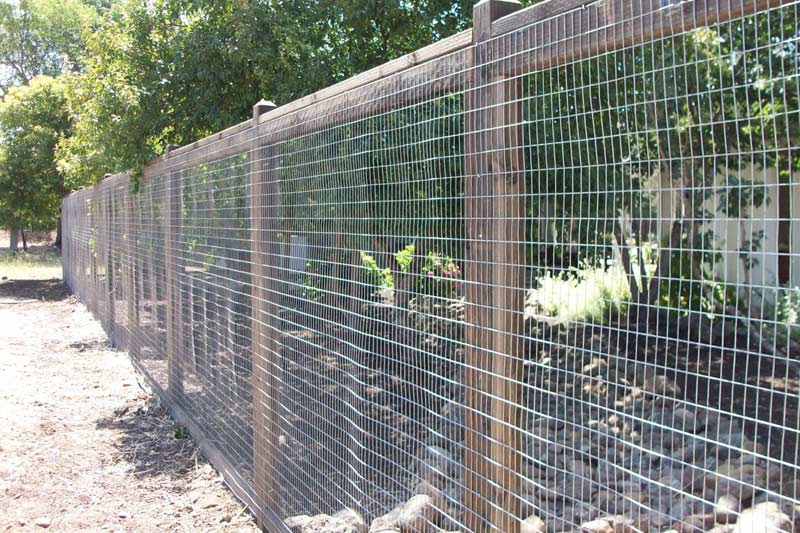
Hog wire fences steal the spotlight when it comes to keeping pigs safe and sound. They’re not just any old fence; they’re super flexible and can even jazz up your backyard. Perfect for anyone looking to combine safety with style!
You can also opt for a metal post as an alternative to the wooden posts that a hog wire is often attached to. The average cost to install a hog wire fence with metal posts will be between $2.5 and $4 per foot.
Attaching your hog wire fence to a metal post is an alternative to the typical wooden fence. This option can provide a sturdier, more durable fence post requiring less maintenance than its wooden counterpart.
Hog wire fence post cost by material
The cost of installing a hog wire fence is about $3 – $5 per foot. The cost for the fence post is typically included in the total expense.
To maximize the purpose and usage of your hog wire fence, it is best to have them attached to fence posts and have them securely installed on the ground. Two of the most common fence post options are wooden or metal fence posts.
When purchasing fence posts individually, such as metal star pickets or treated pine posts will cost from $1.5 – $8 each. The factors that can affect this cost depend on the material, the height, and the quality that you have chosen.
Wooden fence post
Since hog wire fences are commonly framed using wood, using a wooden fence post can make your hog wire fence more visually appealing and coherent.
One of the disadvantages of having wooden fence posts is that they are highly likely to rot over time, which may require you to maintain or replace them periodically.
Some wooden fence posts come or can be installed with decorative components. This type of fence post also comes in various thicknesses and is best utilized for livestock or agricultural purposes.
Installing your hog wire fence using a wooden fence post can cost you around $8 to $13 per post. The final cost depends on the height of the post, and the type of wood that you will choose.
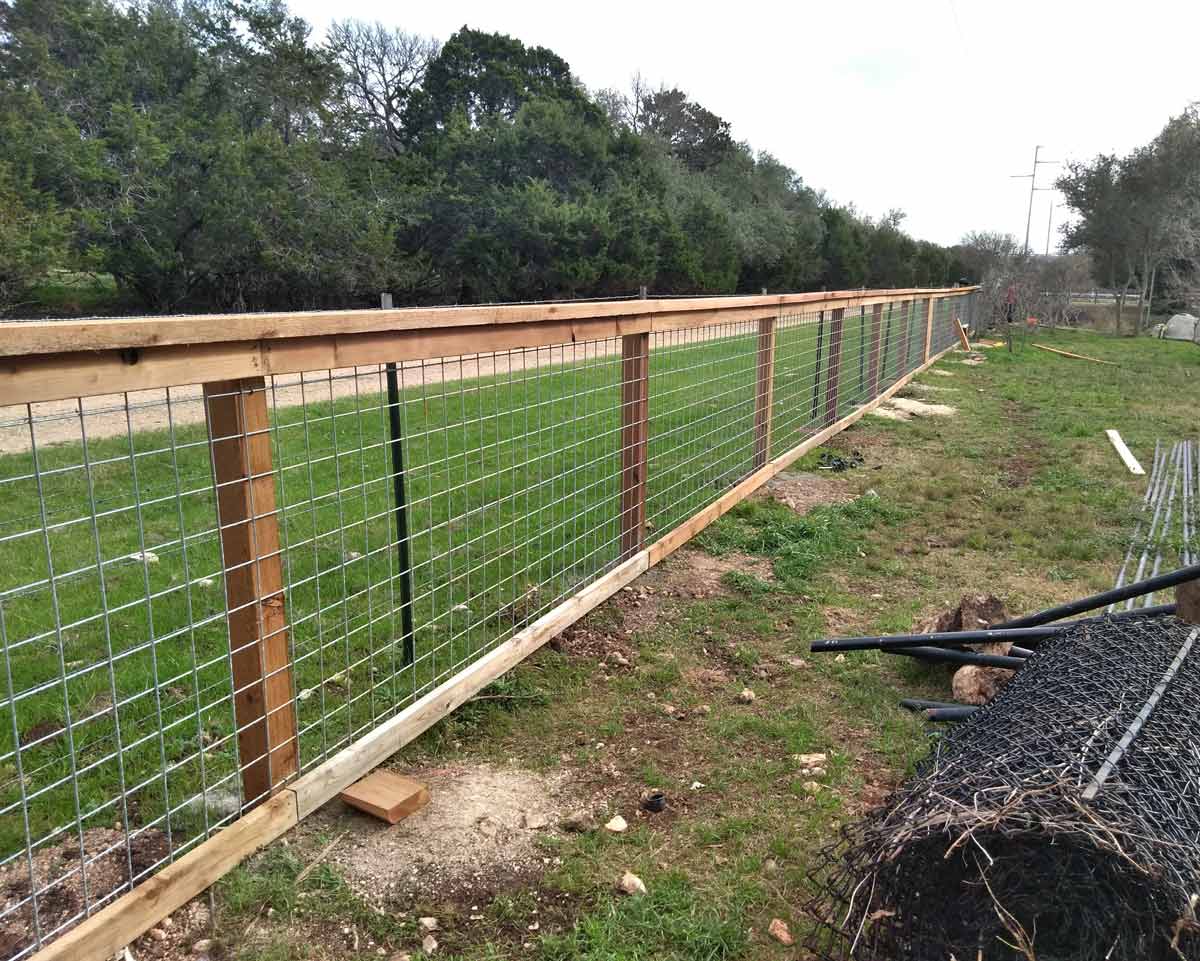
Metal fence post
When pairing your hog wire fence with metal posts, you can choose between thin rods to more solid and thick pieces. Typically, thinner metal fence posts are best paired with lightweight wire fencing.
If you choose to install your hog wire fence using metal fence posts, you can expect to spend an average cost range of $1.5 – $3.75 each, not including its installation.
Normally, metal fence posts are more durable compared to wooden fence posts, and they also require little maintenance compared to its counterpart.
Hog wire fence cost per acre
If you have landscaping that sports a rustic look, a garden, or if you keep livestock on your property, you may need to install a hog-wire fence installed in your property.
As an average cost, people would spend between $1,200 to $2,800 to install a hog wire fence with a height of 5 feet in a 1/4-acre garden. Most homeowners spend around $2,000 for this size using cedar frames.
For scale, a low-end version of this fencing project for a 1/4-acre garden with 4 feet height of unframed hog wire attached to wooden posts would cost $600.
A high-end version of the same size but with a height of 6 feet, painted wooden frames, and a complement gate would cost around $4,000.
For reference, below are the average costs to install a hog wire fence:
| Description | Average Cost |
|---|---|
| National Average Cost to Install a Hog Wire Fence | $2,000 |
| Low-End Hog Wire Fencing | $600 |
| Average Range to Install a Hog Wire Fence | $1,200 to $2,800 |
| High-End Hog Wire Fencing | $4,000 |
Hog wire fence with wooden frames
While some situations and preferences might make you decide to install a hog wire fence without a frame, the option to have the wire be framed with wood is still a viable option.
Framing a hog wire fence with wood can help it become more secure and sturdier, making it last for a longer period.
The cost to install a frameless hog wire fence can range between $2 to $3 per linear foot. On the other hand, installing a framed hog wire fence can range from $3 to $10 per linear foot.
For your reference, below are some of the average costs per acre to have a hog wire fence that is framed with wood. For scale, one acre is equivalent to 836 linear feet:
| Hog wire fence with wooden frames (per acre) | Average cost to install |
|---|---|
| 1 Acre | $2,508 to $8,360 |
| 2 Acre | $5,016 to $16,720 |
| 3 Acre | $7,524 to $25,080 |
| 4 Acre | $10,032 to $33,440 |
| 5 Acre | $12,540 to $41,800 |
If you are looking for an alternative that does not require framing, you can still use hog wire fencing without one, and it can save you some expenses. However, it may not be as durable and effective, especially if you do it to add small security.
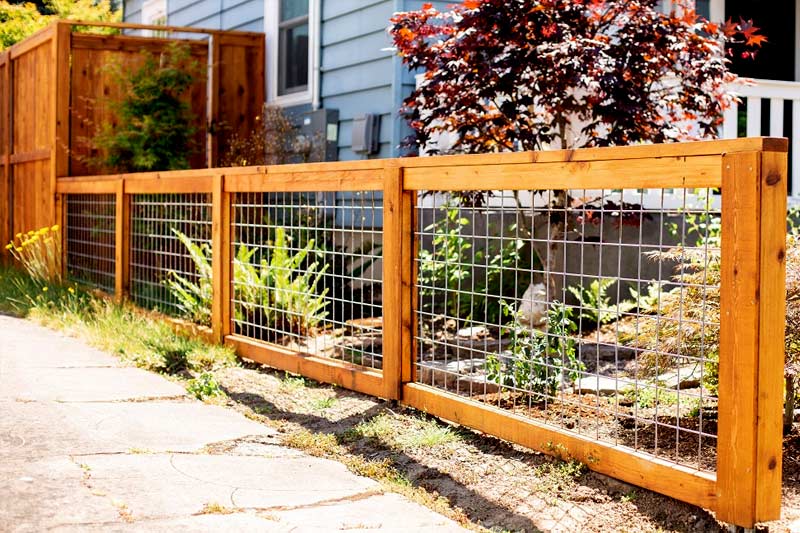
Hog wire fence cost by size
One of the factors that can affect the cost of your hog wire fence installation is the size of the fence. Typically, you can purchase readymade panels with a length of 16 feet and heights of 3, 4, 5, or 6 feet. A variety of 8 feet tall hog wire is also available.
You can also buy rolls of hog wire that can stretch up to 100 linear feet, with various heights from 3 feet to 8 feet. This would cost you over $1 per linear foot for the material alone.
Should you be looking for a privacy fence for your residence, think about opting for a board on board fence. This fence style is created by interlocking wooden boards in a way that leaves no spaces for outsiders to glance through, making it an excellent choice for maintaining privacy.
The average of a board on board fence is $2,250 – $4,250 to install a 500 linear ft. Per foot, this works out to be around $4.50 – $8.50.
Below, we break down some of the costs you’ll incur during the fence installation to help you budget better.
Average cost of a board-on-board fence
The total amount you’ll spend on board-on-board fencing installation will vary depending on a number of factors. This could range from the size of the fence, to the materials you’ll use, to whether you’ll hire a pro or handle the job as a DIY.
Therefore, the average cost to install this fencing could be as low as $2,000 or as high as $11,000. It will all depend on the nature of your fencing project.
Most homeowners, however, spend between $2,000 – $6,000, bringing the national average for board-on-board fence installation to $4,000.
Here’s a breakdown of these costs, including materials, labor, and any tools or supplies required.
| Item | Unit | Low | Average | High |
|---|---|---|---|---|
| Materials | Per sq. ft | $2 | $10 | $15 |
| Labor | Per hour. | $30 | $50 | $70 |
| Supplies and tools | Per 100 linear ft | $100 | $175 | $250 |
| Average cost | per linear ft. | $4 | $13 | $22 |
| Total cost | 500 linear ft. | $2,000 | $6,500 | $11,000 |
Cost of board on board fencing per linear foot
The average cost of board-on-board fencing stands between $4 and $22 per linear foot. This massive range is caused by the cost difference in the materials used for installation.
In terms of square feet, you can expect to spend $15 – $20 per sq. ft for the fence installation.
Labor cost to build a board-on-board fence
How much you’ll spend on labor will depend on the contractors you hire for the installation. Most professionals will charge you anywhere from $30 – $70 per hour for the job, or around $4 – $7 per linear ft.
The labor time will, however, be longer or shorter depending on the materials being installed and the size of the boards used.
Expect most contractors to take between 25 – 40 hours to complete your board-on-board fence installation. Tips are welcomed by installers but certainly not expected.
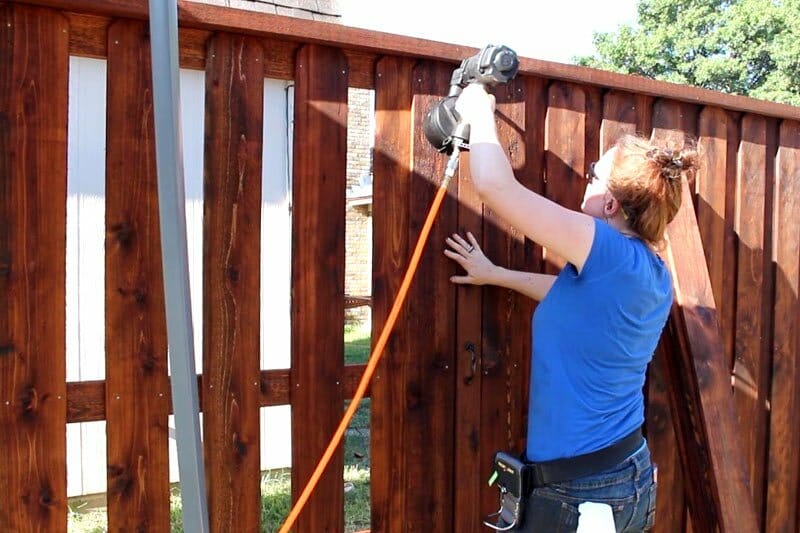
Cost of board-on-board fence by material
One of the biggest advantages of a board on board fencing is the flexibility it gives you on material choices. Among the most popular options for homeowners includes vinyl, western red cedar, pine, and cedar fences among others.
You, therefore, get to choose the material that works with the visual effect you want for your home.
But as you’d guess, each of these materials varies in price.
Generally, the premium materials (mainly hardwoods) will cost you much more than the softer fence materials. Most fencing contractors will also charge more in labor to install the premium materials.
Additionally, board-on-board fences tend to utilize at least 30% more material than other privacy fences because their boards overlap on the same side, leaving no spaces or gaps.
Here’s how much some of these materials cost per 6-foot plank.
| Material | Low | High |
|---|---|---|
| Vinyl | $10 | $35+ |
| Composite | $8 | $12 |
| Cypress | $2 | $3 |
| Bamboo | $6 | $12 |
| Pressure-treated pine | $2 | $6 |
| Tropical hardwoods | $10 | $20 |
| Cedar | $2 | $4 |
| White Oak | $8 | $12 |
| Black locust | $8 | $12 |
| Western red cedar | $8 | $10 |
| Spruce | $4 | $8 |
| Redwood | $8 | $10 |
Wood board on board fences
Wood is the most popular material used on board-on-board fences. It’s actually what most people think of when they hear of privacy fences. The most common types of wood used in board-on-board installations include:
- Redwood
- Pressure-treated pine
- Western red cedar
- Eastern white cedar
The average cost to install wood board on board fences ranges between $2 – $12 per linear foot.
Vinyl board on board fences
For homeowners that don’t like wood, vinyl is another popular material used for a board on board installation. The material is simple to install, durable, and easy to clean and maintain.
Vinyl also doesn’t rot or crack when exposed to temperature changes, making it perfect as a long-term investment.
Expect to spend anywhere from $10 – $35+ per linear ft. on the vinyl board on board fence installation.
Cost to install board on board fencing by size
When purchasing your installation materials, you’ll discover that board on board fencing comes in two options i.e., 6” and 8” options. Your decision to pick either of these options should depend on how high you want your fence to be.
Keep in mind: Most homeowners associations demand that residential fences should remain at a maximum height of 6 feet unless you apply for a variance.
The average cost to purchase a 6” board is usually $4 – $8 per linear ft. while that of the 8” board is around $5.20 – $10.50 per linear ft. This indicates a difference of about 30% in cost between the two material sizes.
Cost to install board-on-board fencing by type
There are three major types of board-on-board fencing installation that are popular in the United States today. They include:
Board on board fences with top caps
This is arguably the most popular type of board-on-board fencing. Whether wooden or vinyl, most homeowners prefer adding a top cap to their fence posts.
These caps are important not only for adding aesthetic appeal to the fence but in wooden fences, they also help prevent moisture from reaching the top ends of your pickets.
Adding top caps to your fence will increase your overall installation costs by around 5%.
Board on board fence with prebuilt panels
In some cases, you might find that manufacturers sell pre-assembled fence panels made from wood or vinyl. Many homeowners prefer this type of board-on-board fence because it’s so much easier to install.
The prebuilt fence panels are usually 6 feet in length and can vary in thickness depending on the material.
It’s also easy to contact the manufacturer and ask for custom pre-built panels that suit your home style – even though this increases the costs.
The average cost of prebuilt fence panels ranges between $50 – $200 per panel stack.
Horizontal board on board
If you are tired of the vertical board on board fence design, you can ask your contractor to try the horizontal design instead. For this, he/she will attach the pickets horizontally to the fence posts.
The costs to do this installation are relatively the same as that of installing vertical pickets. The only extra cost would be that of using high-quality wood or vinyl to ensure the middle parts of the fence don’t sag.
Board on board fence permit and inspection costs
Before proceeding with your fence installation, most zoning boards will demand that you obtain a permit to put up the fence. This usually costs anywhere from $75 – $200 for a 6” fence.
If you however want to build or replace a taller fence, the permit may cost you around $200 – $400.
Check your local building codes or consult a local contractor to determine if you’ll need the permit in your area.
Cost to remove old board-on-board fence
If the contractor has to remove an old board-on-board fence before installing the new one, your total costs will also increase. Most contractors will charge you between $20 – $60 per linear foot for the removal.
So, for a standard 200 linear ft. fence, a contractor will charge you $4,000 – $12,000. These costs could be even higher if your yard or lawn is sloping.
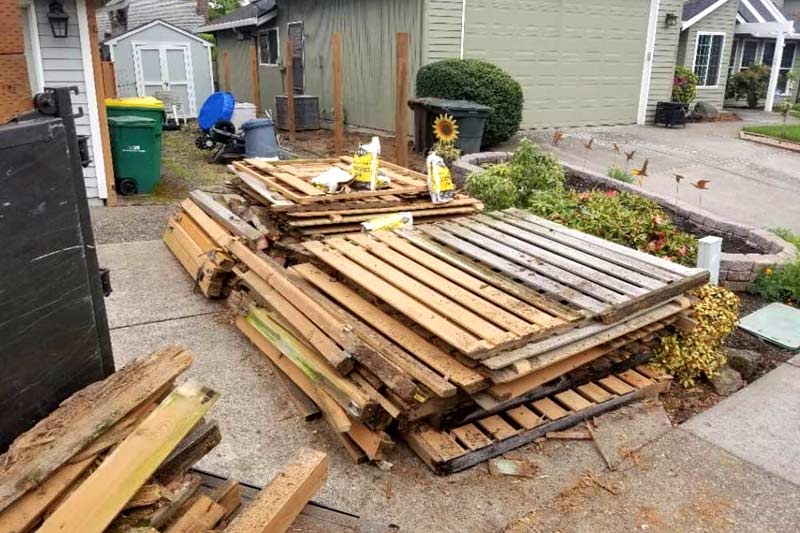
Additional cost factors affecting board on board fence installation
Other factors that a fence contractor may consider when quoting your fencing job may include:
Land surveyor
Once you’ve obtained your fence permits, you might still need to hire a land surveyor who’ll determine the location of your property lines.
Doing this is important if you don’t know the exact location of your boundaries as it ensures you don’t encroach on your neighbor’s property.
The average cost of hiring a land surveyor may range anywhere from $300 – $800.
Slope of the land
The cost of installing your board on board fence will also increase if your land has an incline. This is because the contractor will have more work to do, including grading the land before beginning the installation.
The cost of land grading may cost you an extra $900 – $3,000 depending on the size of land to be covered.
Bush clearing
If the space where you intend to install the fence is overrun with bushes and trees, you’ll need to spend some extra cash for their removal.
Hiring a local handyman to help you with the bush clearing and disposal will cost you anywhere from $100 – $500 depending on the size of the bushes.
Board on board fence vs Shadow-box fence
While these two fences appear to be very similar, the biggest difference between a board-on-board fence and the shadow-box fence is that the board on board fence leaves no gaps.
The shadow box fence is constructed using overlapping pickets attached to the opposite sides of the fence. This leaves small gaps for airflow.
In terms of cost, installing a shadow box fence will cost you around $17 – $35 per linear ft.
Board on board fence vs Stockade style fence
The board-on-board fence is also often confused for the stockade fencing. Initially, they’re both very similar because like board on board fences, the stockade is installed with the fence panels next to each other, leaving no gaps.
But over time, the panels on the stockade fence tend to shrink and the gaps on the fence begin to show. Meanwhile, board on board fences never have gaps.
The average cost to install a stockade-style fence ranges from $15 – $20 per linear ft.
DIY fence installation vs hiring a pro
The best thing about installing fences is that it can be done as a DIY. As long as you have the right tools and some experience, the job can be done. On average, most DIY fence installers take 50 – 60 hours to complete installation.
DIY cost to install board on board fence
For a successful board-on-board installation, your biggest costs will be the materials and acquiring the required equipment. The materials alone will cost you anywhere from $4 – $22 per linear ft. depending on what you go for.
Equipment will cost you between $250 – $500 in total, but it may be cheaper if you already had some tools.
While it’s clear that these costs are much lower than what you’d spend on a local contractor, it’s still quite pricey to handle if you don’t know what you’re doing.
As such, hiring a professional is always the best idea. This way, you’ll be guaranteed quality work in the shortest time possible.
Looking for a fencing contractor?
HomeGardenGuides.com has a great tool that quickly matches you with trusted fencing contractors in your locality. You can get three estimates from local fencing professionals in just under two minutes! All you have to do is follow the three simple steps below:
- Scroll to the top of the page and enter your zip code
- Answer questions about your board on board fencing project
- Your board-on-board fencing project details are forwarded to three local experts who will send you a price estimate for your job with some friendly advice.
IMPORTANT: There is no obligation to hire any of the contractors. This is a free tool and service to be used at your pleasure.

FAQ's
In some cases, yes. Due to the overlapping nature of the fence panels, board on board fences tend to use up more materials than other side by side fence styles making them relatively more expensive.
It depends on the material used. Most wooden fences will last for around 20 or more years, while vinyl fences last for around 20-30 years.
No. While they have a similar appearance, board on board fences have overlapping panels on the same side of the fence leaving no gaps while shadowbox fences have overlapping panels on opposite fence sides which tend to leave gaps.
Installing a barrier for farming needs to keep livestock enclosed is crucial and offers great advantages as it secures your domestic animals in a specified zone.
In having a fence to help contain and safeguard your livestock, you can expect to spend between $1 to $8 per linear foot. This estimated cost can differ depending on the type of fence, the size of the project, the height, and others.
In selecting the type of fence that you want to have installed, you should first consider the kind of livestock you are keeping, the quality that you want, and the purposes that you want your fence to be of use for.
Types of livestock fencing and their costs
High-tensile fencing
One of the most effective and worthwhile fencing types.
The best option for livestock because of its robust characteristics, and construction design.
Is relatively easy to install, but would require multiple strands to properly secure your perimeter.
| High-tensile wire type | Average cost range |
|---|---|
| High-Tensile Wire (Non-Electric) | $0.02 - $0.03 per strand |
| High-Tensile Bare Wire (Electric) | $0.03 - $0.12 per strand |
| High-Tensile Barbed Wire | $0.03 - $0.05 per strand |
| Electric High-Tensile Polymer | $0.10 - $0.15 per line |
| High-Tensile Polymer Rail | $0.80 - $0.90 |
| High-Tensile Polymer (Non-Electric) | $0.11 - $0.13 per line |
Barbed wire fence
Commonly used for keeping livestock and cattle in a provided area, this type of fence is typically made of steel, with sharp and pointed wires sticking out for added security.
Intruders, animals, or predators are repelled by the barbs that can cause injury. This also adds another layer of security for those who attempt to break or pass through the wire.
For barbed wire fences, there are two types: security and livestock.
For reference, below are the average prices for barbed wire fences:
| Description | Average Cost |
|---|---|
| Barbed Wire Fence per foot (Livestock) | $1.25 to $3.50 per foot |
| Barbed Wire Fence per foot (Security/Razor) | $1 to $3 per foot |
| Barbed Wire (Construction) 5 strands 12-gauge For a 1,300-foot fence | $1,900 |
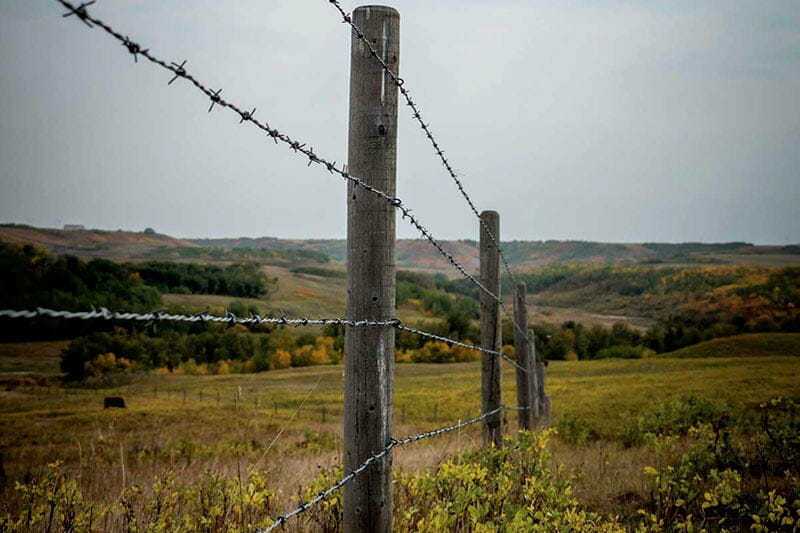
Chain link wire fence
Is usually paired with barbed wire fencing for optimum effectiveness and security. However, for those who don’t want the risk of injuring their livestock, it can also act as a standalone fence.
Cost-friendly and lightweight, yet strong enough to create an effective boundary marker for properties, residential markers, pet spaces, and small livestock.
For reference, below are the average prices for chain link wire fences:
| Description | Average Cost per linear foot |
|---|---|
| Chain Link Fence (4ft height) | $7 to $12 |
| Additional Height | $1 to $2 |
| Additional Privacy Slats | $3 to $5 |
| Additional Fabric Screen | $3 |
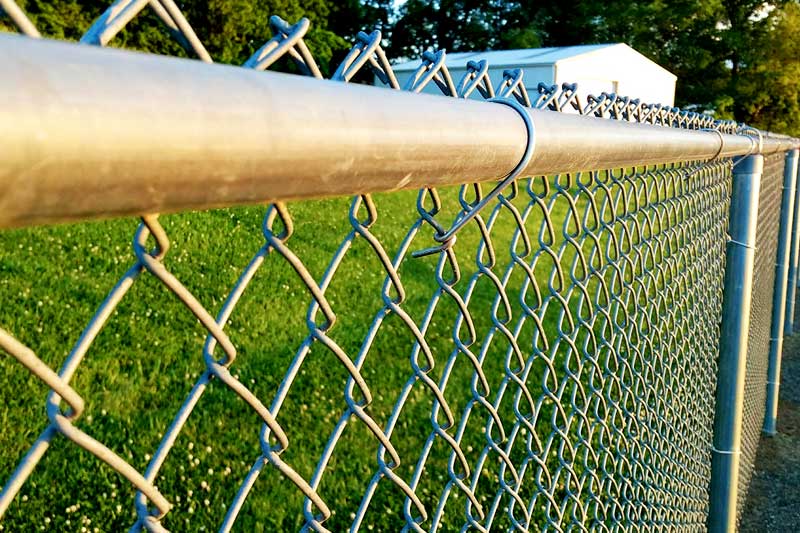
Chicken wire fence
Chicken wire fences are commonly used for their flexible, strong, and durable characteristics.
Named after its most common purpose, chicken wire fences are also used to keep squirrels, rabbits, mice, and other small animals contained safely in a specific area..
The average cost to install a chicken wire fence can range between $2 to $4.50 per linear foot.
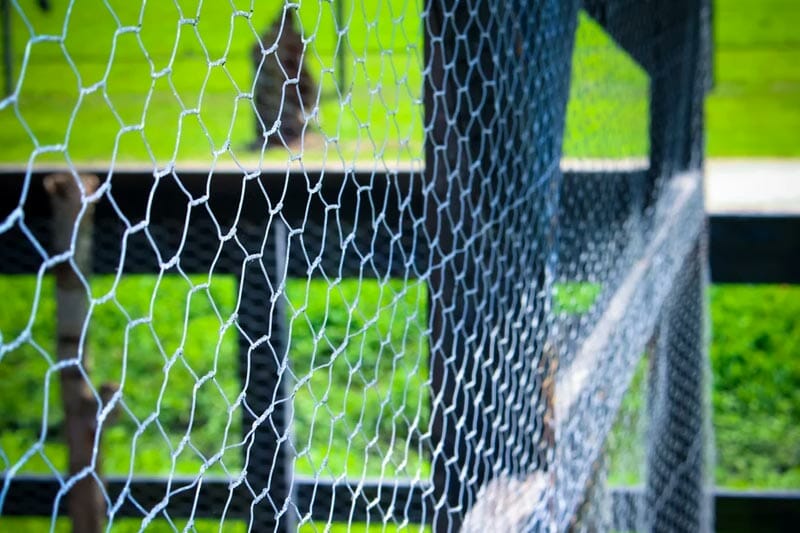
Horse fencing
This type of livestock fencing also has various styles, and a variety of materials that you can choose from such as metal pipes, classic split rail wood, or even electric.
The cost to install a horse fence can include multiple factors such as the size of the field needing to be fenced, the selection of materials, labor costs, and the height of the fence.
The cost to install a horse fence can run between the ballpark range of $3.70 to $30 per linear foot. Normally, installing a horse fence for a 100-linear feet area can run between $1,500 to $3,200.
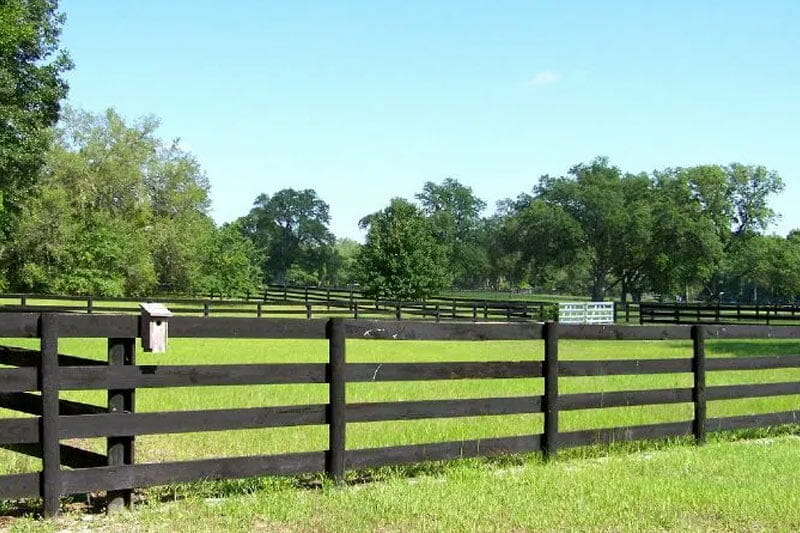
Woven wire fence
Also known as “page wire” or “sheep fencing”, a woven wire fence is made of wire nets of lightweight horizontal and vertical wire that are intersected with one another.
Typically, this wire is stretched and attached to opposite fence posts to enclose a given area.
For optimum security, property owners often pair this fence type with barbs at the top as a way of increasing its effectiveness.
For reference, below is the average cost for installing a woven wire fence:
| Description | Average Cost |
|---|---|
| Woven Wire Fence | $1.48 to $1.85 per linear foot |
| Woven Wire Fence 100 feet long; 5 feet height 2” x 4” mesh | $180 per roll |
| Woven Wire (4ft by 300ft) 330 feet length; 4 feet height 6” by 6” mesh | $189 per roll |

Fence post cost for livestock fencing
Normally, for any fence to be effective and efficient, they need to be attached to sturdy and reliable posts.
When it comes to installing a livestock fence, the charge for the posts is typically part of the total expense of the fencing project. Although this may be applicable in bulk projects, you may have to pay for them individually in some situations.
For instance, if you only need to repair, or replace a damaged fence post, or if you deem extending your fenced property, you may only need to purchase it individually as additional material.
You can spend somewhere between $20 to $60 to purchase a fence post, including the cost of its installation. The factors that can affect the cost can differ based on the type of the fence, the material of the fence, and its height.
To help you choose the type of fence post that best serves your type of livestock fence, below are two of the widely used variations:
Wood fence post
Wooden fence posts come in different kinds and thicknesses, which can be used for various types of fences.
Some wooden fence posts can be installed with decorative elements for added visual appeal.
For fences that use wooden frames, pairing it with this type of fence post adds a visual coherence, and can be visually pleasing.
The average cost for a wooden fence post is around $20 to $50 per post.
Metal fence post
Depending on the required foundation of your chosen fence type, there is a variety of metal fence posts that you can choose. These variations differ from thinner rods to more solid, robust pieces.
For lightweight fencing, thinner metal posts are more appropriate and sufficient.
For heavy and stronger fences, thick and sturdier fence posts are required and are suitable.
Typically, metal posts can be more durable compared to its counterparts. Additionally, metal posts require less maintenance and upkeep.
While they may be more durable, metal fence posts can be less appealing compared to wooden fence posts. However, decorative elements can still be attached to it.
The average cost for a metal fence can run between $25 to $60 each.
Other types of livestock fencing and their characteristics
Most of the time, property owners who keep livestock prefer a certain type of fencing to help protect and keep their animals and agriculture. Normally, a single type of fence is not a one-shoe-fits-all since each serves a specific purpose.
Typically, it can be tricky to keep sheep, goats, pigs, and poultry in a given space since they can easily climb over and crawl under certain types of fences. Luckily there are types of livestock fences that can solve this problem.
Below are some of the types of livestock fencing and their characteristics:
| Types of livestock fences | Characteristics |
|---|---|
| Hinge joint fence | Also referred to as farm fencing, this type has four wrap hinge joints that intertwine the wires. Has various height options to help keep different animals. Various horizontal wire spacing to allow various growth periods and tensile strength. Is best for safekeeping rabbits, cats, chickens, sheep, deers, and horses. |
| Fixed knot fence | This type combines the hinge joint with high tensile steel wire, which has stronger fabrics and can be installed faster with lesser use of fence posts. Comes in various height variations, which can cater to your livestock fencing needs, depending on the animal that you want to safe keep. Is ideal for safekeeping cattle, camels, horses, and deers. |
| High tensile wire fencing | This type of fencing makes use of highly robust, and high-tension wires that are not stretchable. With this, the wire prevents animals from passing and climbing through, since it cannot be easily bent or damaged. Utilizes lesser fence posts, and can be installed with wider spacing. While this type can be more on the costly side, high tensile wire fencing has a longer lifespan. |
| Chicken wire fence | Chicken wire adopts the characteristics of galvanized wire, stainless steel wire, and PVC coated wire. The result allows for an impressive anti-corrosion and durable fence wire. With steel wires that are woven into hexagon meshes, the chicken wire fence is a great choice for lightweight fencing. This type is ideal for keeping chickens, goose, rabbits, other small animals, and garden purposes. |
| Barbed wire fencing | Barbed wire fencing serves as highly effective for keeping docile livestock such as cattle. Its effectiveness comes from its construction where it repels animals or people away from the fence because of its pointed edges. This type is not advised for people who are keeping horses or camels who are at risk of running into the fence and causing themselves unwanted injuries. |
| Steel wire hex deer fence | Also called metal hex deer fencing, this type is metal coated with black PVC, allowing it to be the best deer fencing. It can offer less visible, more durable, and stronger deer fencing. This is best for property owners who keep deers who frequently damage fences from chewing, or for those who want to have better fencing. |
Labor cost to install a livestock fence
Typically, it would take a professional 1 to 3 days to finish a fence project. Although this may be a reliable estimate, the actual duration can still differ depending on factors such as the fence type, the size of the project, and other conditions.
If you hire a professional to install your livestock fence, you can expect to spend around $40 to $60 per hour. This estimated cost translates to $0.92 to $5 per foot in labor costs.
On top of the standard labor cost, another factor can contribute to the cost. For instance, if your terrain is uneven, you may be required to have it re-sloped. Availing of this necessary service can cost you an average of $1,300.
While it may be obvious that the total cost of your entire fencing project may balloon because of the labor costs, this investment will not be wasted.
Installing a livestock fence: DIY vs hiring a contractor
Having a livestock fence installed on your property can be quite taxing and difficult, especially if you are not used to working with heavy tools and extensive labor.
While hiring a professional can increase your total cost, this expense can come advantageous and necessary because you can assure that the person who is keeping your livestock safe is of experience and expertise.
Additionally, hiring a professional can assure you that your livestock fence is secure and professionally done, saving you the trouble of paying for any rework or repair in case the fence is badly installed or poorly done.
How much does it cost to install pipe fencing, which is known as one of the leading methods of fencing for farms?
You will pay $10-$15 per foot for pipe fencing. The price includes the cost of materials and installation. The average cost of materials ranges from $2 to $20 per foot.
How much you will pay for the pipe fencing projects depends on the size of the land.
What is a pipe fence
A pipe fence is a fence made of metal pipes. It is corrosion-resistant and robust. Consequently, it has a useful lifespan of about 20-30 years.
Many farms use pipe fences. However, you can use them on any other type of land.
Factors affecting pipe fence cost
Fencing material
The fence material you choose to use determines how much land fencing will cost.
Metal makes most pipes for fencing. The price of steel has been rising over the last few years. As a result, it will cost you more to fence your land with pipe fencing than wooden posts or any other cheaper material.
You will pay $7-$10 per foot of pipe fencing, while it costs $3-$9 per foot when you use wooden posts.
Further, the fencing material you choose depends on the type of land you are fencing and its use.

Size of the land
The size of the land to fence implies how much money you will spend. The larger the plot, the more you will pay.
The amount of materials you need depends on the size of the land. The more materials you need, the more you will spend on fencing.
Further, the larger the land, the more you pay for labor.
Pipe fencing is suitable for any size of land. You can use it in small plots or large farms.
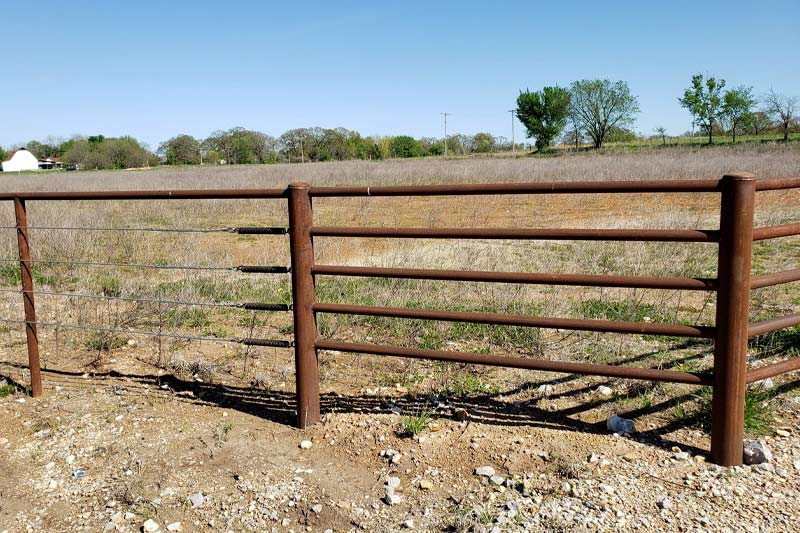
Land topography
How the land looks also determines how much you spend on fencing.
It costs more to fence a sloping land than flat land.
Since sloping land is harder to work on, it will cost you more to fence it.
When working on flat land, the work will move fast and will not require advanced tools or carrying heavy loads over large distances.
Usually, sloping land needs grading to make it easy to work. The cost of grading increases the cost of fencing.
Labor cost
You can DIY or hire a pro to help install a fence on your land. You will save on labor costs if you DIY. However, fencing land is a job best left to professionals.
The larger your land, the more you will pay for fencing. The slopier your land, the more difficult it is to work on, and the more you will pay.
Labor cost is additional to the material cost. Hence, increasing the fencing cost. Labor costs depend on the location of your land, the expertise of those you hire, and more.
Fence height
The higher the fence, the more it costs.
Fences are 6ft high. However, depending on the land you are fencing, you may need a higher one. Privacy fences are at least 8ft in height.
The higher the fence, the more materials it needs. Thus, the higher the cost. It will also take longer to install, increasing the labor costs.
Obstacles on the land
The more obstacles on the land, the higher the fencing cost. Trees are some of the fencing obstacles.
If there are trees on the fencing path, you have to remove them or go around them. Tree removal is expensive and is an additional cost when fencing your land.
If you have to go around the trees, you increase the distance for fence laying. As a result, you will need more posts which increases the cost of fencing.
Existing fence
Replacing an existing fence increases the cost of fencing. The pros you hire will charge extra for old fence removal. Also, it increases the time for new fence installation.
It is best to remove the fence before your hired pros get to the site. It will help you save money.
If your existing fence is usable, you can repair it. It will save you the cost of purchasing and installing a new one.
Benefits of pipe fencing
Strength
Metal pipes have sufficient tensile strength compared to other fencing posts. They can withstand strong hits without denting or breaking, unlike wooden posts. Steel pipes are difficult to ram down when properly installed.
Cost-effective
While it may be expensive to purchase and install pipe fencing, its usage is cost-effective. Once installed, it requires little maintenance. Since it does not attract pests, you do not have to keep inspecting and spraying chemicals.
Additionally, it is corrosion-resistant. You will not incur additional expenses to paint it regularly. Steel pipe fencing is also fire-resistant.
Durability
Steel pipes have a long lifespan. They last for 25-30 years before you have to replace them. Combined with its low maintenance cost, you have a fence that you will not need to spend money on after installation.
Eco-friendly
Recycled scrap metal is the source of material to manufacture pipe fencing. Thus, making it an environmentally friendly product. It does not leave any residue on the ground as it ages. Additionally, the pipes can be recycled and made into other steel products or new pipe fencing when removed.
Easy to install
Steel fence pipes are not as bulky as wooden posts making them easy to work.
When you use hydraulic drivers, you can install the pipes without digging or pouring concrete. Thus, you save time when working with steel than other materials.
Alternative farm fencing methods
High tensile wire fence
A high tensile wire fence can either be electric or non-electric. You will need six strands of the wire for proper fencing.
It costs $0.12-$0.18 per foot to purchase the non-electric high tensile wire. You will pay $0.18-$0.72 per foot to purchase the electric tensile wire fence materials. You will also pay additional labor costs to install the fence on your land.
It is durable and low-maintenance. Suitable for ranch fencing due to its high tensile strength. Animals get easily entangled by the wire due to its low visibility. You can use markers to make it more visible.
Vinyl horse fence
You will pay $0.90 to $1.60 per rail per foot of vinyl horse fence. Its price is considerably high compared to steel pipe fencing or other materials.
Vinyl is durable and requires little maintenance. It is best used in warm climate regions. In cold regions, it can become brittle and break.
Vinyl fences can be used at home and on agricultural land. It is safe for animals and people. Further, it does not break easily and will not injure animals or people.

Split rail fencing
You will pay $12-$30 per foot to purchase materials and install split rail fencing on your land. It keeps animals from straying and demarcates land easily.
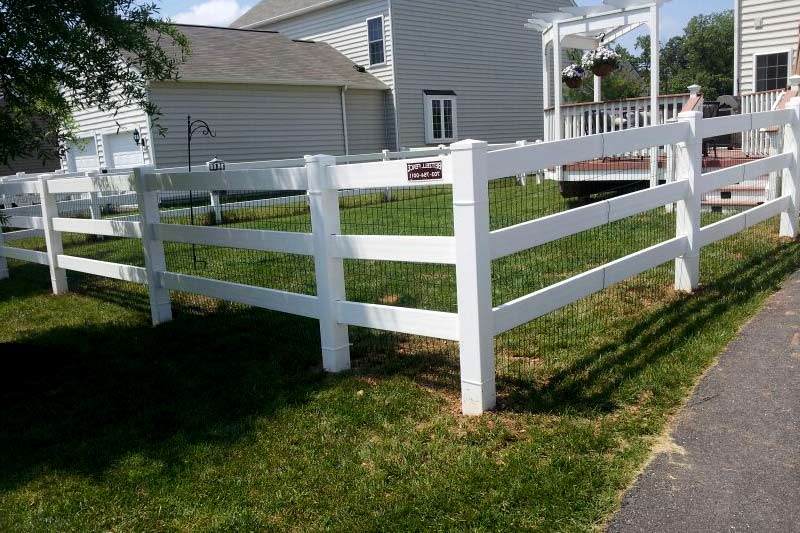
Barbed wire
Barbed wire is the cheapest farm fencing alternative. It costs $0.03-$0,05 per strand per foot. It is ideal for farmland. It keeps animals enclosed and safe.
Barbed wire requires regular inspection and tightening if it gets loose. It has sharp parts that may injure your animals when they get too close.

No climb fence
Post and rail or field fences can also add no climb mesh to better protect livestock. It costs $1.39-$1.89 for materials only. It is attractive and strong enough to keep animals from straying or knocking them down. It is best installed in even landscapes and may require regular tightening to keep it working well.
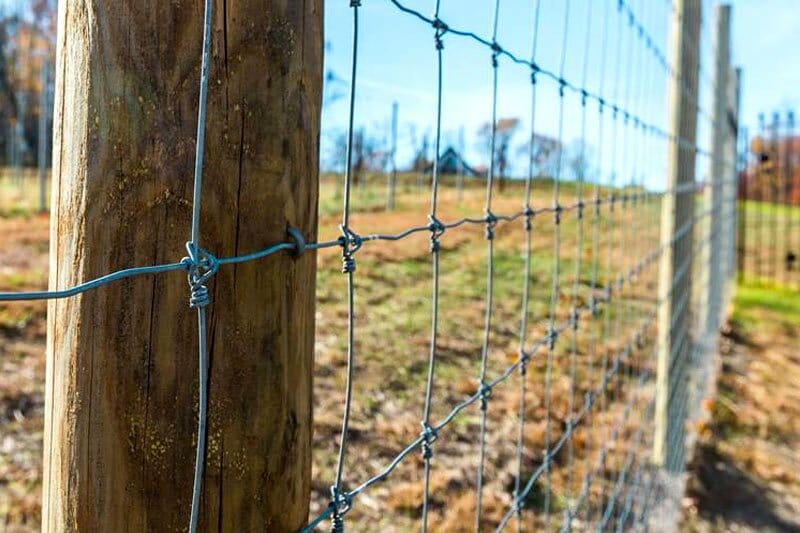
DIY vs hiring a pro cost
Depending on the fence materials you use, you can DIY or hire a pro for fence installation.
DIY pros
- Save money. You only spend money on the purchase of materials. It will cost you $2-$20 per linear foot to install a fence by yourself.
- Install the fence as you want.
DIY cons
- You may have to hire tools if you do not have your own. It may use up the money you saved and more.
- Likely to make errors if you do not know how to install fences.
- May take you a lot of time.
Pros of hiring a pro
- Saves time since the work is completed by trained professionals.
- No errors.
- Pros are insured to pay for medical injuries and other accidents at the site.
- May bring their materials
- High quality of workmanship.
Cons of hiring a pro
- Expensive. It costs $4 to $26 for a pro to install a fence on your land. The cost includes materials and labor.
How to hire a pro for your pipe fencing
Homegardenguides.com is a free tool to hire professional fence installation service providers.
It connects homeowners to professionals in the following easy steps.
- Enter your zip code at the top of the tool.
- Fill in the form to provide more details about the fencing service you need.
- You will receive three or four quotes and advice from professional fence materials and installation companies
- Contact and hire a land clearing service that falls within your budget.

Factors to consider when choosing a fence design
Cost
When choosing a fence design, you must have a budget. Your budget will provide the direction in how you design your fence.
The higher the budget, the more expensive materials you can get and the higher you can pay pros. Consequently, the more exquisite the fence design you can get.
A low budget allows you to purchase low-priced fence materials and limits you to affordable fence designs.
Fencing costs quickly add up. Thus, the higher your budget, the better a fence design you can get.
Lifespan
When choosing a fence design, you need to consider the durability of the fence. How long a fence life is determined by the fence material. Some have a longer lifespan than others.
Pests and rotting affect the lifespan of wooden fence posts. Consequently, wooden fences will not have a long lifespan.
Steel pipe fences are not affected by pests and rotting, and neither do they rust. Thus, they have a lifespan of 25-30 years, They are also affordable to purchase and are low maintenance, making them ideal for fence materials.
Intended use
The intended use of a fence determines its design. A fence installed at home will have a different design from one at a farm. A privacy fence has a different design from a picket fence even when you use the same material.
When choosing a fence design, ensure that you know where the fence will be installed. The location of the fence also determines its intended use.
Maintenance
When choosing a fence design, determine how much money and time you will spend to maintain the fence. The higher the maintenance cost, the more expensive it is to keep or install the fence. A fence should be easy to maintain.
Different fence materials have different maintenance requirements. Wooden fences require more maintenance than other types. They have to be treated and painted to prevent pests and rotting. They also need proper drainage to prevent them from rotting when they touch the water.
Other materials may only require painting every few years.
Installation
Depending on the design you choose, you could DIY or hire a pro to install the fence. The easier the design, the easier it is to install the fence by yourself. For a complicated design, you will have to hire a pro to install it.
Permits
Depending on where you live, you may need a permit to install a fence. Consult with a pro to find out if you do.
Wire fences are versatile and provide numerous benefits. They are frequently employed by property and homeowners to ensure that animals remain safely contained within a specific zone, while some also use these fences as a defense mechanism against predators.
As a ballpark average, you can expect to pay between the range of $1,250 to $8,000 to have a wire fence installed. On the other hand, the average cost for a fence post can range between $20 and $60.
While these may be the average cost range, the final fence post and wire fence cost would still depend on the type of post and fence that you want, the material that you prefer, the size of the project, and the quality of the fence that you want.
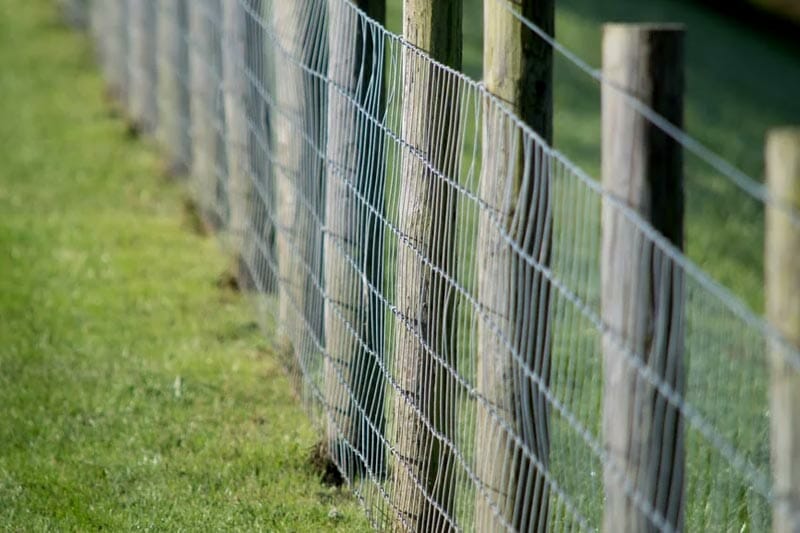
Wire fencing cost per foot
Having a wire fence post could be for various reasons. Others utilize them for keeping poultry and livestock, others use them for additional privacy, and others have them to provide more security to their homes and properties.
Depending on the type and its inherent quality, the cost to install a wire fence can range between $1 to $8 per linear foot. The factors that can affect the cost can include the type of wire, the height of the fence, the posts, and the materials.
Wire fences are used for various reasons, and their prices also vary depending on the purposes and quality that they provide. Below are some of the wire fence types, and their average costs per foot.
| Wire fence type | Average cost per foot |
|---|---|
| Woven wire fence | $1.48 to $1.85 |
| Hog wire | $0.75 to $3.25 |
| Barbed wire (Livestock) | $1.25 to $3.50 |
| Chicken wire | $2.00 to $4.00 |
| Chain-link (4ft height) | $7.00 to $12.00 |
Wire fence national average cost
There are a lot of contributing factors that affect the cost to install a wire fence. As the national average, you can expect to spend an average cost of $2,400 to have a wire fence installed on your property.
Although this may be the expected average, the cost can still vary depending on the material, the size of the project, and the quality of the fence. For the basis, below are the national averages depending on the quality of the wire fence.
| Description | Average Cost |
|---|---|
| Average Range | $1,250 to $8,000 |
| Low-End Wire Fence Installation Cost | $836 |
| High-End Wire Fence Installation Cost | $12,500 |
| National Average Cost | $2,400 |
The figures above are calculated based on the average cost of installing a wire fence per linear foot, which ranges between $1 to $8.
Types of wire fencing and their cost per foot
Normally, the cost of installing a type of wire fence will depend on the type of fence that you want, the height of the fence, and the purposes that it shall serve.
For the basis, below are the estimated average cost and range costs for the various types of wire fences.
Barbed wire fence
This type of fence is typically made of steel and is commonly used for safekeeping livestock and cattle in a given area.
People or animals that attempt to pass or break the barbed wire are instantly repelled by the sharp and pointed bards that can inflict injury, giving effective security against predators and intruders.
For barbed wire fences, there are two types: security and livestock.
For reference, below are the average prices for barbed wire fences:
| Description | Average Cost |
|---|---|
| Barbed Wire Fence per foot (Livestock) | $1.25 to $3.50 per foot |
| Barbed Wire Fence per foot (Security/Razor) | $1 to $3 per foot |
| Barbed Wire (Construction) 5 strands 12-gauge For a 1,300-foot fence | $1,900 |
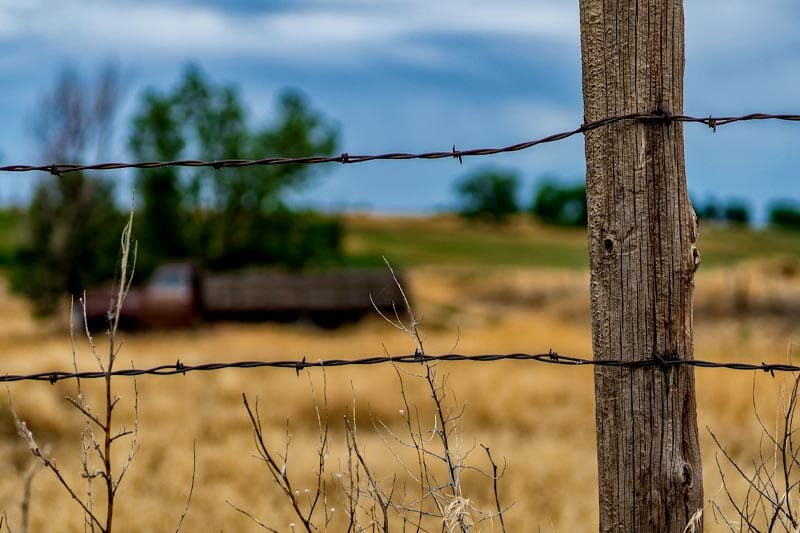
Chicken wire fence
Chicken wire fences are commonly used for their flexible, strong, and durable characteristics.
Named after its most common purpose, chicken wire fences are also used to keep squirrels, rabbits, mice, and other small animals contained in an area.
The average cost to install a chicken wire fence can range between $2 to $4.50 per linear foot.
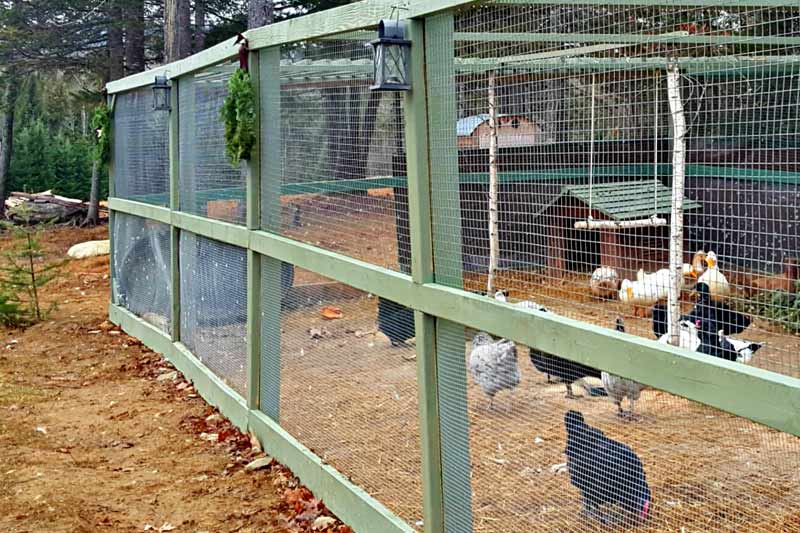
Hog wire fence
Although primarily used for creating pens and containing hogs, hog wire fences are also used for residential purposes.
Most of the time, hog wires are attached to wooden fences after being framed with wood. This adds an aesthetic factor, especially in residential areas.
The average cost to install a hog wire fence can range between $3 to $5.
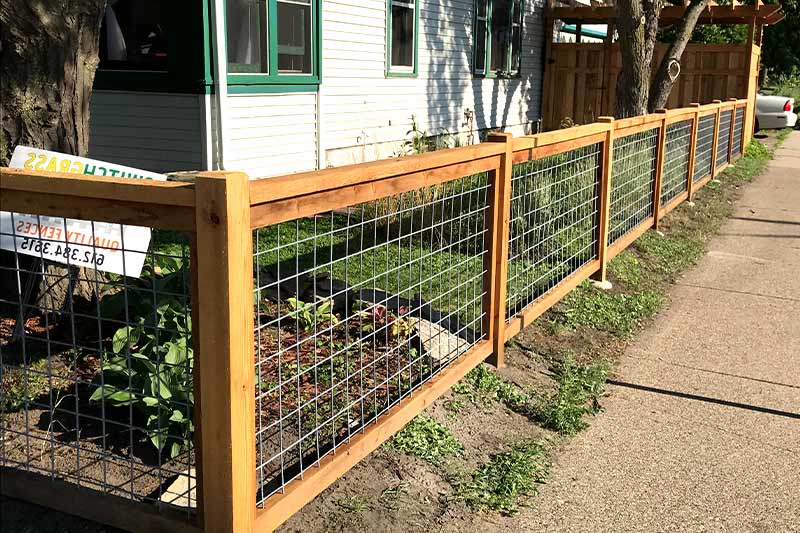
Chain-link wire fence
Chain-link wire fences are known due to their lightweight characteristic and their affordability. While lightweight, they are also sturdy enough to make an effective boundary for animal spaces, and properties.
Chain-link wire fences can also be paired with barbed wire to have additional security.
The average cost of chain link fence installation is $2,350 depending on the height and style being installed.
| Description | Average Cost per linear foot |
|---|---|
| Chain Link Fence (4ft height) | $7 to $12 |
| Additional Height | $1 to $2 |
| Additional Privacy Slats | $3 to $5 |
| Additional Fabric Screen | $3 |
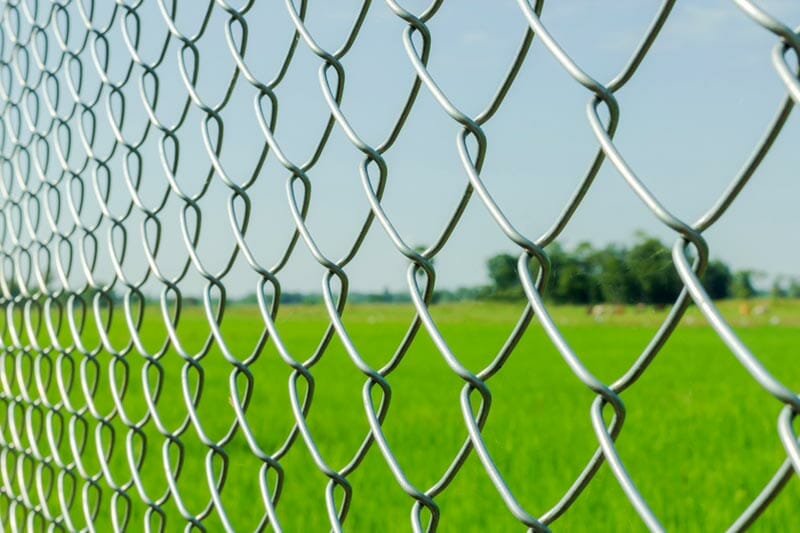
Woven wire fence
Also referred to as “sheep fencing” or “page wire”, woven wire fences are wire nets of lightweight intersecting horizontal and vertical wires. They are usually stretched and attached to opposite stakes.
This type of fencing is common for safekeeping goats, pigs, and sheep.
Some people add barbed wire at the top to improve its effectiveness and improve security.
| Description | Average Cost |
|---|---|
| Woven Wire Fence | $1.48 to $1.85 per linear foot |
| Woven Wire Fence 100 feet long; 5 feet height 2” x 4” mesh | $180 per roll |
| Woven Wire (4ft by 300ft) 330 feet length; 4 feet height 6” by 6” mesh | $189 per roll |

Fence post cost by material
In installing a fence, the expense for the posts is usually included in the total cost of the project. However, in situations where you only need to replace or if you want to extend the fence, the cost for the fence posts will be billed separately.
On average, you can expect to spend somewhere around the range of $20 to $60 for the fence post and the installation. The cost will differ depending on the initial type of fence, and the material of the fence post that you have chosen.
In choosing the type of post that you want for your fence, you should first consider the characteristics of the wire fence, including the necessary post that you should pair it with.
Wood fence post
Some wood fence posts have decorative tops and are usually used for mesh wire or wooden frames.
This type also comes in different thicknesses and serves best for livestock safekeeping.
The average cost to have a wooden fence post is around $20 to $50 per post.
Metal fence post
There are a variety of kinds of metal posts that you can choose from, depending on the necessary construction. You can choose from thin rods to more solid pieces.
Thinner metal posts are used for lightweight fencing, and the counterpart is used for heavier and sturdier fencing.
Normally, metal posts are more durable compared to wood fences. They also require less maintenance; however, they can be less versatile and less appealing compared to wood fences.
The average cost for a metal fence post is between $25 to $60 each.
A woven wire fence, often called a field fence, is recognized as the best option for safeguarding farms and ranches. It is purposely crafted to keep animals like horses and cattle enclosed within a specified zone.
In installing a field fence, you can expect to spend between $1 to $8 per linear foot. The factors that can affect the cost include the type of wire that you choose, the height of the fence, and the fence post.
There are some considerations that come with selecting the type of field fence for your property. Some of these include the wire gauge, knot style, spacing, height, the length of the fence, and the purposes that you want it to serve.
Cost to Install a Field Fence per Foot
In having your field fence installed, the amount of money that you spend is determined by the number of feet required. As a ballpark cost, you can expect to spend between $1 to $8 per linear foot.
For reference, below are the average costs of installing a field fence at a given length:
| Field Fence Length | Average Cost (including installation) |
|---|---|
| 25 linear feet of field fence | $25 to $200 |
| 50 linear feet of field fence | $50 to $400 |
| 75 linear feet of field fence | $75 to $600 |
| 100 linear feet of field fence | $100 to $800 |
| 150 linear feet of field fence | $150 to $1,200 |
| 200 linear feet of field fence | $200 to $1,600 |
| 300 linear feet of field fence | $300 to $2,400 |
| 400 linear feet of field fence | $400 to $3,200 |
The final cost can vary based on the type of the wire that you choose, and the height of the fence. Usually, most fences stand 26 to 48 inches tall. However, some fences can be modified to be taller especially for keeping horses.
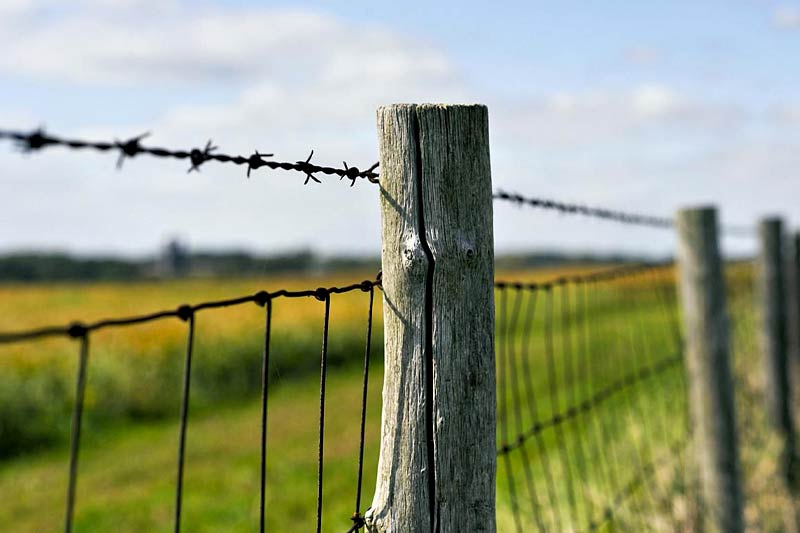
Cost to Install a Field Fence per Acre
If you are installing a field fence on a large scale, you may be billed per acre instead of per foot. For this, you can expect to spend somewhere between the range of $836 to $6,688 per acre, including the labor cost for the hired contractor.
For reference, below are the average costs of installing a field fence per acre, including labor costs:
| Field Fence per Acre | Average Cost (including installation and labor costs) |
|---|---|
| 1 Acre | $836 to $6,688 |
| 2 Acre | $1,672 to $13,376 |
| 3 Acre | $2,508 to $20,064 |
| 4 Acre | $3,344 to $26,752 |
| 5 Acre | $4,180 to $33,440 |
The final cost for installing a field wire fence per acre may include factors such as the type of the material, the height, and the type of terrain where you will install the fence.
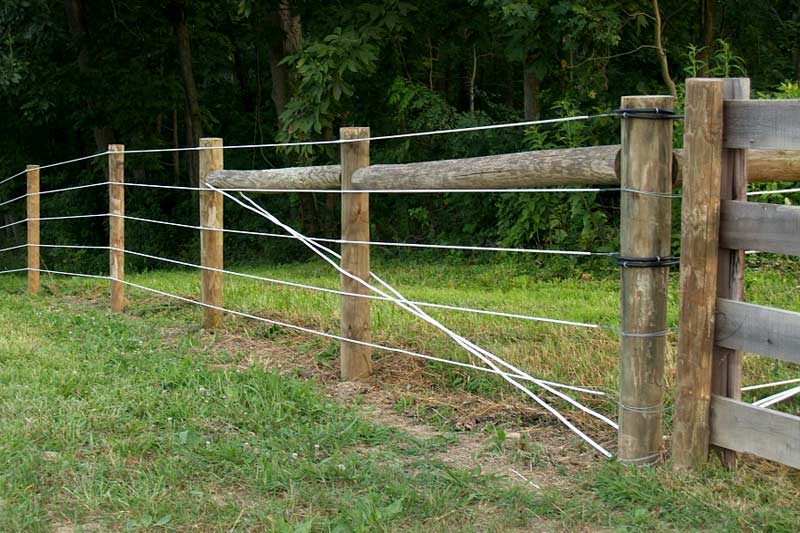
Field Fence Installation Cost Calculator
In calculating the total cost of your fencing project, you have to consider factors such as the type of material, the height of the fence, the labor rate, the accessibility of your property, and added features like gates and decorative elements.
On average, you can expect to pay for the job in the range of $600 to $635, excluding the materials. Typically, property owners spend from $550 to $750 to install a horse fence, for example. The final cost depends on the type and size.
To help you estimate the total cost of your field fence installation, below are some of the cost factors that you can include in calculating:
Project Size by Foot or Acre
- If you will hire a professional to install your fence, you can expect to spend an additional $2 to $6 per linear foot on top of the cost of the materials.
- For instance, if you need to install over a square acre that requires 830 feet of fencing, you can expect to spend an additional $1,660 to $4,980 for the labor costs.
- Normally, the exact costs will depend on your local labor rates, the height of your desired fence, and the number of rails that you want to install.
- Other cost considerations include the condition of your soil where the fence will be installed. If your terrain is uneven, it may incur additional time, equipment, and cost to make it even and conducive for fencing.
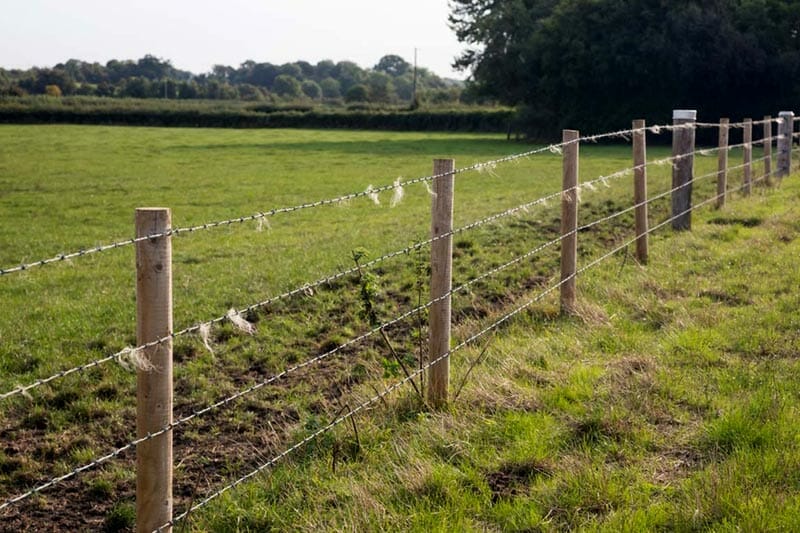
Gates
- Some property owners find it convenient to add one or more gates to their fenced spaces to allow more entry/exit points. This, of course, comes at an additional cost.
- To install a livestock gate, you can expect to spend an additional cost between $150 to $400.
- Typically, these gates are made of tubular, welded steel that is less likely to warp, rot, or get easily damaged like wood.
- The cost of adding a gate can vary depending on its length and height (usually from 6 to 16 feet), its size, style, and other considerable factors.
Material cost to install a field fence
With field fences, you can select from a number of options for the material. Depending on your needs, the type of material can help you build a functional fence while saving costs.
Below are the average costs for the type of material that you want for your field fence:
| Type of material | Cost per foot (excluding fence post) |
|---|---|
| Wood Post and Board | $3 to $9 |
| Vinyl (PVC, Nylon, or Polyethylene) | $1.50 to $3 |
| Woven Wire | $1.50 to $5.90 |
| Bull | $3 to $7 |
| Hog | $3 to $10 |
| Chicken | $2 to $4.50 |
| Welded | $4 to $10 |
Fence post cost by material
In installing a new fence, regardless of its type, the cost for the posts is usually part of the entire fence project cost. However, this might not be the case, especially when you only need to replace or extend your existing fence.
To be functional and secure, field fences must be affixed to fence posts that are securely installed on the ground. Your fence post can depend on the type of field fence that you want to install.
As an average cost, you can expect to spend somewhere between $20 to $60, including its installation. This estimated cost can depend on the material and your desired quality.

Wooden Fence Posts
Sometimes, wood posts can come with decorative tops and are preferred to be used in combination with wooden frames and mesh wires. This type also comes in different thicknesses and is usually applied best in livestock fencing.
The average cost for a wood post to be installed falls between $20 to $50 per post.
Wood posts are popular for their aesthetic appeal since they appear better compared to metal posts. They are also more versatile and more configurable compared to its counterpart.
One of the disadvantages of wood fence posts is that they are more prone to natural rotting, which may require you to perform regular maintenance or periodic replacement for them.
Metal Fence Posts
In choosing metal fence posts, you can select from thinner rods to more robust and solid pieces. Usually, thin rods are used for lightweight fencing, and the more solid types are used for more robust and heavy-duty fences.
The average cost to install a metal fence post is between $25 to $60 per post, including its installation.
To determine the type of metal post you would need for your field fence, you have to know how strong you need your fence to be. Some of the factors can include the kind of animal that you keep and the purpose you need it to serve.
Normally, metal posts are more durable compared to their counterparts. This type also requires less maintenance. However, one of the drawbacks is that they can be less versatile and not visually appealing.

Types of Field Fences and Their Characteristics
| Type of Field Fence | Characteristics |
|---|---|
| Hinge Joint Fence | Also referred to as farm fencing, this type has four wrap hinge joints that intertwine the wires. Has various height options to help keep different animals. Various horizontal wire spacing to allow various growth periods and tensile strength. Is best for safekeeping rabbits, cats, chickens, sheep, deers, and horses. |
| Fixed Knot Fence | This type combines the hinge joint with high tensile steel wire, which has stronger fabrics and can be installed faster with lesser use of fence posts. Comes in various height variations. Is ideal for safekeeping cattle, camels, horses, and deers. |
| Chicken Wire Fence | Chicken wire adopts the characteristics of galvanized wire, stainless steel wire, and PVC coated wire. The result allows for an impressive anti-corrosion and durable fence wire. With steel wires that are woven into hexagon meshes, the chicken wire fence is a great choice for lightweight fencing. This type is ideal for keeping chicken, goose, rabbit, and garden purposes. |
| Steel Wire Hex Deer Fence | Also called metal hex deer fencing, this type is metal coated with black PVC, allowing it to be the best deer fencing. It can offer less visible, more durable, and stronger deer fencing. This is best for property owners who keep deers who frequently damage fences from chewing, or for those who want to have better fencing. |
Installing a Field Fence: Hiring a Contractor vs DIY
Installing a field fence can be quite a labor-intensive process. The tasks can include but are not limited to, planning, measuring, procurement of materials, and the installation itself.
Some people who have experience with tools may find this task doable; however, there might be necessary equipment and expertise that you may not find in your shed.
Although hiring a professional can significantly increase your total expense, this price can come worthwhile since a professional will surely have the skills and expertise to properly install your field fence.
Moreover, doing so would assure you that the structure is professionally done, saving you the risk of paying more for the repair and rework or if it costs you unwanted accidents with your important livestock and cattle.
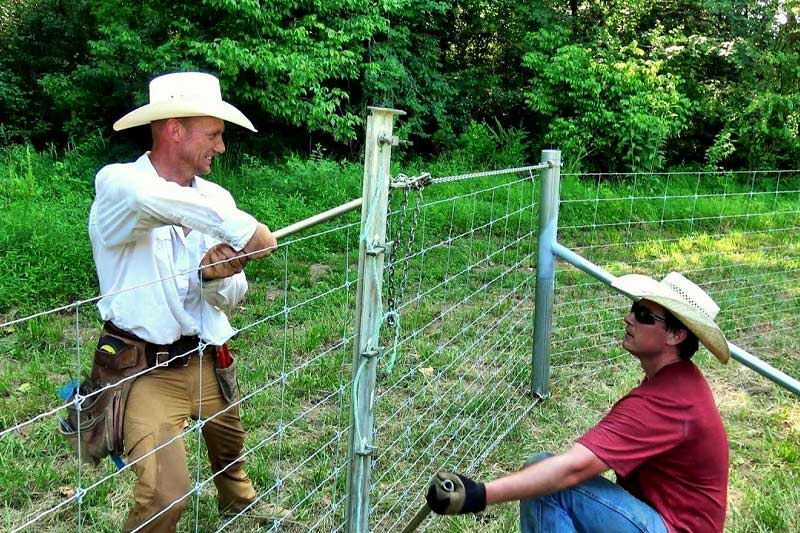
How long does it take to install a field fence?
The time it would take to install a field fence can depend on multiple factors. These can include the job size, terrain conditions, weather conditions, and the number of gates you want to have, should there be any.
Most of the time, field fences can be installed in 1 to 3 days. As a rule of thumb, it should not take weeks, especially when the fence posts, gates, and rails are already installed.
If your hired contractor takes weeks to finish the job, they may be over-extending their job, making you pay more.
Types of field fences and their characteristics
Field fences and their types are not a one-size-fits-all situation. Depending on the type of animal that you keep, or the purposes that you want your field fence to serve, your field fence type, material, height, and quality can vary.
| Type of field fence | Characteristics |
|---|---|
| Deer fence | The height of deer fences can usually range between 6 feet to 15 feet high. However, 6-foot tall deer fences are rare since most deers can leap over them. Deer fences can either be a poly fence or a steel fence. Steel wire deer fencing can offer less visibility. |
| Hinge joint fence | Also referred to as farm fencing, this type has four wrap hinge joints that intertwine the wires. Has various height options to help keep different animals. Various horizontal wire spacing to allow various growth periods and tensile strength. Is best for safekeeping rabbits, cats, chickens, sheep, deers, and horses. |
| Camel fence | Also called “cattle fence”, this type is best used for keeping camels or as borders in fields and grassland. Camel fences can protect camels from damage and can do a great job in keeping camels contained in a specific space. This type comes in a fixed knot or hinge joint fencing variations. Also suitable for cattle, horses, deer, and sheep. |
| Fixed knot fence | This type combines the hinge joint with high tensile steel wire, which has stronger fabrics and can be installed faster with lesser use of fence posts. Comes in various height variations. Is ideal for safekeeping cattle, camels, horses, and deers. |
| Chicken wire fence | Chicken wire adopts the characteristics of galvanized wire, stainless steel wire, and PVC coated wire. The result allows for an impressive anti-corrosion and durable fence wire. With steel wires that are woven into hexagon meshes, the chicken wire fence is a great choice for lightweight fencing. This type is ideal for keeping chicken, goose, rabbit, and garden purposes. |
| Corral panels | This type of field fencing refers to large pens that are used for fencing cattle, horses, sheep, and other livestock animals. Corral panels are usually made of powder coating steel tubing or quality hot-dipped galvanized steel tubing. Comes in round, square, and oval tube variations. A few of the distinct characteristics of corral panels are that they are robust, portable, and have excellent rust resistance, and are not corrosive. This type is best for keeping horses, cattle, and sheep. |
| Steel wire hex deer fence | Also called metal hex deer fencing, this type is metal coated with black PVC, allowing it to be the best deer fencing. It can offer less visible, more durable, and stronger deer fencing. This is best for property owners who keep deers who frequently damage fences from chewing, or for those who want to have better fencing. |
Putting up a fence around your home or property can significantly increase privacy and security. It also offers reassurance for your family and pets. Moreover, a fence introduces a fashionable feature that enhances the look of your home.
Homeowners can expect to spend an average cost range of $5 to $12 per linear foot for the materials, and an average cost range of $15 to $22 per linear foot for installing a horizontal fence.
While it was more common to have a vertical fence, installing a horizontal fence has slowly gained popularity because of its modern look. Aside from that, it makes properties appear longer and bigger, without forsaking the added privacy.
Horizontal wood fence prices by type/species
Often, homeowners or property owners can already assume to pay more or less based on the height and length of the fence. However, one cost factor that is often overlooked is the type of wood selected for the fence.
Most of the time, fences are made from treated redwood, cedar, pine, or other water-resistant lumber material. Some homeowners also prefer to seal and apply something to it to not let it warp and rot.
Below are some of the most preferred types of lumber used for installing a 6-foot-tall fence, their pros and cons, and their average costs per linear foot of material.
| Type of wood | Pros | Cons | Average cost (per linear foot) |
|---|---|---|---|
| Cedar | Insect and rot repellant if it is pressure treated Cost-friendly | Requires yearly maintenance such as sealing, sanding, and wood-staining Can be dented and scratched easily Turns gray over time if not properly sealed and stained. | $3 to $7 |
| Spruce or Whitewood | Cost-friendly | Can decay in 8 to 10 years Prone to graying or darkening The pickets tend to shrink wherever it dries | $6 to $7 |
| Redwood | Best for staining and repainting Naturally fire-resistant and pest-repellant Do not easily warp | Can easily develop mold and damage by the sun if not properly and regularly maintained | $4 to $7 |
| Pressure-Treated Pine | Cost-Friendly Insect-repellant and does not easily rot if pressure-treated | Can warp, split, and shrink especially in dry environments If burned, the pressure-treated pine will release harmful chemicals if burned | $3 to $7 |
| Cypress | Durable and dense type of wood that is similar to pine Has natural components that can be insect and pest-repellant Rot-resistant and can last for a long time, especially in areas that experience rain and snow | Costly | $10 to $15 |
| White Oak | Can last for a long time, especially when you treat the wood A popular choice due to its light finishes Can be resistant to rotting | Is on the pricier side Can warp and bow especially in extremely damp and humid environments | $15 to $40 |
| Black Locust | Very durable and does not require extensive maintenance Ideal for agricultural purposes where maintenance is not as frequent | Due to its rarity compared to its counterparts, Black Locust wood panels can be expensive and hard to procure | $20 to $40 |
Horizontal fence post price
Normally, fence posts are made from wood, metal, or concrete that is then grounded in gravel, cement, or soil. Ultimately, the choice of your fence post depends on your liking and the construction requirements.
As a ballpark cost, purchasing a fence post can run up to $5 to $75 each, which excludes the fee for its installation or additional treatment.
The cost relies heavily on the type of material used in the fence post. Usually, properties or homeowners opt for wood posts for their wood fences to match the look. However; there are still other options available.
Below are the other options for fence posts, their average price per material, and their average cost of installation.
| Fence post type/ material | Average Cost (per material) | Average Cost (including installation) |
|---|---|---|
| Wood fence post | $5 to $20 | $10 to $50 |
| Concrete fence post | $10 to $50 | $30 to $100 |
| Metal fence post | $5 to $30 | $10 to $60 |
| Brick or stone fence post | $25 to $75 | $50 to $150 |
Hiring a fencing contractor
Before hiring a professional fencing contractor to help you have a quality horizontal wood fence, there are a few checklist items to tick before you have them start on the project.
The grade of material used for the fence
Normally, your price will depend on the quality of the wood you have chosen. Make sure that the contractor knows your needs and preferred option of wood and sticks to it when the project starts.
Sometimes, some wood types look similar to one another but are not necessarily the same, especially in their characteristics.
Quality of Materials
Ideally, your hired contractor must use stainless steel fasteners/nails. They should also avoid non-galvanized steel that can darken or bleed black in your fresh fence.
The grade of steel
As a rule of thumb in using steel posts, you should not have them install less than schedule-20 steel posts. Any type under that standard will easily break, especially in heavy winds.
Warranty and quality of service
Your hired contractors should have a history and certification in honoring labor warranties.
The hired professional should also have the necessary experience and expertise in constructing and installing horizontal wood fences.
Clear deal and contract
Before signing a professional on your fencing project, you should make sure that the terms are clear and not vague. Items such as labor fees, additional costs, warranties, and others should be agreed upon.
Doing so does not only protect your interests but would also assure the hired contractor that the project is arranged and will be worthwhile.

Cost to DIY a horizontal wood fence
Homeowners that are familiar with home improvement and have power tools will find the building and installation of a wood fence easy. Doing so can save money since it does not require paying for a professional’s service.
However, having zero experience in home improvements can make the task very difficult. In this case, hiring a contractor to handle the fencing project might be the smarter choice.
If you are unsure if you can do it yourself, you might end up spending thousands and loads of hours, only to have an unsatisfactory fence for your property.
Necessary tools/factors to consider before DIY horizontal wood fence installation
Below are some of the necessary items and factors that you need to have and consider before doing a DIY horizontal fence:
Equipment and tools
Normally, you would need tools to build a horizontal fence. If you already own some of these, you won’t need to spend on another one. If you don’t, below are some of the tools and their average prices.
| Equipment / Tool | Average cost |
|---|---|
| Work Gloves | $5 |
| Protective Safety Glasses | $16 |
| Paint Brush | $15 |
| Spray Paint | $5 |
| Mason’s Line | $15 |
| Tape Measure | $18 |
| Hand Saw | $16 |
| Claw Hammer | $20 |
| Post Hole Digger | $50 |
| Power Drill | $80 |
| Level | $21 |
| Total | $266 |
Materials
Typically, the cost for the materials will depend on the type of wood that you will use and the size of the area where you will install your fence. Below are the ballpark costs of the necessary materials:
| Materials | Cost (per item) | Cost (per 150-foot wood fence) |
|---|---|---|
| Box Nails | $12 | (not applicable) |
| Deck Screws | $23 | (not applicable) |
| Concrete Mix | $20 | (not applicable) |
| Gravel | $400 | (not applicable) |
| Wood Stain | $125 | (not applicable) |
| Pickets | $5 | $1,640 |
| Horizontal Rails | $13 | $1,640 |
| Fence Posts | $28 | $560 |
| Total | $3,300 |
Horizontal fence vs vertical fence
Aside from providing additional privacy and security to your home, horizontal and vertical fences can help define the borders of your property, regardless of whether yours is a residential or commercial property.
Below are some of the differences between horizontal and vertical fences:
The openness of backyard
Vertical fences can have boards with spaces in between boards that can offer visibility of your backyard. This variation can be best if you want your space not to be entirely closed off.
If you want your property to have total privacy, horizontal fences may be the best pick. This is because horizontal fences rarely have spaces in between the boards, which offers less visibility than its counterpart.
Durability and strength
Horizontal fences are more durable, especially in locations that experience rain and weather damage.
Vertical fences are more prone to natural rotting and weather damage since the top and the wood can easily rot at the base and exposed edges.
Privacy
Because of its general construction design, horizontal fences can guarantee reliable privacy for your property. Since its design has panels closer to each other, it can block external viewing.
With vertical fences, the panels or boards have more spaces in between, making external viewing possible. If you want more privacy with vertical fences, you can consider chain-link instead of wood.
Ease of installation
If you consider doing the fencing project on your own, whether it is a horizontal or vertical fence, you will most likely do it on your own and do a good job.
If your residential or commercial property has uneven terrain, it may be best if you hire a professional since they are more experienced in dealing with fencing on slopes.
Additionally, it might be more suitable to have vertical fencing since it can be challenging to opt for horizontal boards on irregular or uneven ground.
Other considerable differences that make horizontal fences different from its counterpart are the following:
| Horizontal fence | Vertical fence | |
|---|---|---|
| Appearance | Unique, modern, and appears sleeker and impressionable | Appears attractive, but is common and can be considered outdated |
| Cost | Can be more expensive and labor-extensive | Less expensive compared to its counterpart |
| Installation on uneven terrain | Can be more complicated to build on uneven ground or contoured ground. Horizontal fences are best installed on level surfaces. | Can easily be installed even on textured or uneven ground |
| Durability and strength | Can be less sturdy and durable, but can be remedied by installing more vertical posts | It Is more sturdy because of its construction design where it uses 2x4 stringer |
| Availability of pre-built wood panels | Horizontal fence panels must be built on-site | There are pre-built vertical panels that can be bought or ordered |
Advantages of a horizontal wood fence
As initially mentioned above, there are several differences that horizontal fences offer compared to vertical fences. These differences can either cater to your specific fencing needs or can convince you more to choose it.
Below are some of the notable advantages of having a horizontal fence installed.
Variety of styles and designs
One of the best parts of choosing a horizontal fence is that it comes with different styles and design choices. With this, you have multiple options to make your property appear the way you intend it to be.
With horizontal fences, you can choose between split rail, board on board, woven designs, and other types of styles and designs.
With this variety of options, you can make your fence distinct from others, adding more personality and look to your property.
Customizability
If you choose to have a horizontal fence for your home or commercial property, you will have the advantage because you can tweak it so it suits your preference and necessity.
For example, you can have wood-stained panels to match the existing items in your landscape or have them match your gate.
Environmentally friendly
One of the advantages of having horizontal wood fences, especially if you are conscious of the environment, is that they will not damage your surrounding even if they start to rot.
If they start to have damage or rot, you can stain them to repel termite damage. This also means that you do not have to use harmful chemicals that can be dangerous to your health and the environment.
Less waste
In constructing and installing horizontal fences, the panels or boards do not necessarily have to be the same size, unlike vertical fences. This helps you save more money since it won’t waste too much wood.
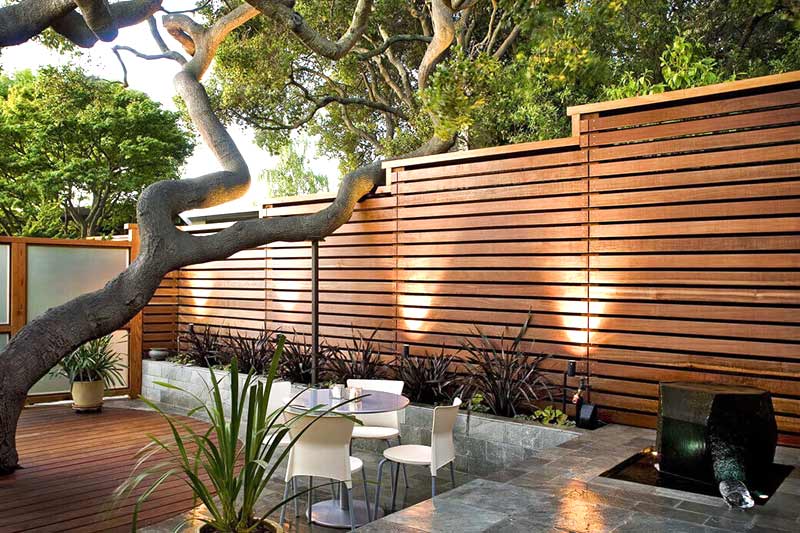
The chicken wire, characterized by its hexagonal mesh, is made from interwoven wire. Its flexibility is perfect for irregular ground surfaces, enabling simple modifications to accommodate different slopes.
The cost of the material for a chicken wire fence ranges from $0.35 to $1 per linear foot. The total expense, including the installation of the fence, could run a ballpark cost of $2 to $4.50 per linear foot.
Chicken wires come in a wide variety of mesh size openings. Not only they are flexible, but they are also very strong and are used in many different ways. They are popular for agricultural purposes, such as keeping poultry and small animals safe.
Chicken wire installation and project cost
Usually, poultry fencing is stapled to wood structures that are typically set at 8-foot or 10-foot fences posts. In choosing the height of your chicken wire fence post, the total cost shall also differ since it changes the number of materials to be used.
For reference, below are the average prices on chicken wire fence installation, the cost of materials, the total project cost assuming a 164-linear foot area, and the average cost per linear foot.
| Description | Materials (wire & posts) | Cost of installation | Project cost (164-linear foot area) | Cost per linear foot |
|---|---|---|---|---|
| Chicken wire fencing (8’ posts) | $154 - $260 | $492 - $820 | $646 - $1080 | $4 - $7 |
| Chicken wire fencing (10’ posts) | $217 - $324 | $492 - $829 | $709 - $1144 | $4 - $7 |
| Chicken wire fencing (18’ posts) | $354 - $452 | $492 - $820 | $837 - $1272 | $5 - $8 |
Woven wire fencing cost per foot
Most professionals who install these fences opt to measure the project by foot. Depending on the material you chose for your woven wire, the installation cost is between $1.10 to $2.50 per linear foot.
The different mesh sizes available for woven wires serve different purposes. They are mainly used on farms and ranches. Woven wires also cost more than barbed wires.
2” x 4” mesh
A 2”x4” mesh is ideal for hoofed animals to prevent them from getting their hooves through the holes of the fence. This could cost around $180 with a roll of 100 ft. that is 5 ft. high.
6” x 6” mesh
A 6”x6” mesh, on the other hand, is appropriate for larger animals like goats, sheep, and cows. Using the standard height for this specific size, a roll of 330 ft. with a height of 4 ft. costs around $189.
Woven wire
Woven wire fencing is often preferred by homeowners as they are more attractive than other wires and are much safer for children and pets. For these reasons, they are more costly than barbed wires.
For the total expenses, the cost of materials and the cost of labor will be added.
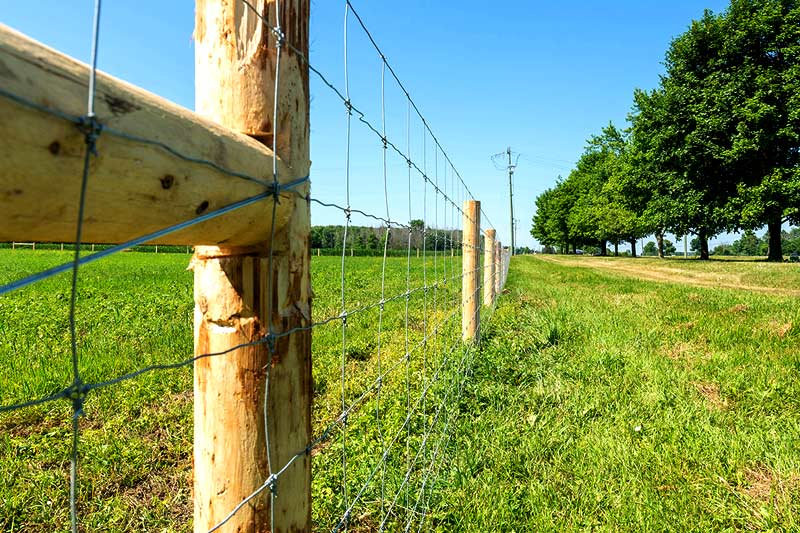
Woven wire fence labor cost
Many fencing companies these days offer an estimated cost calculator on their websites. You only need to input the specific material, the length, and height, and the size of its mesh to figure out their estimated costs including labor.
Labor costs for installing woven wire fences will either be charged by the hour or by the foot. Whether you prefer the one over the other, the project will not start unless a total price is agreed upon by you and your local fencing company.
Woven wire fence cost per hour
Installing a woven wire fence costs about $40 to $60 per hour. A fencing project is charged by the hour, especially when it is not a large project.
Small projects can be completed in 1-3 days, With this timetable, the labor cost could go from $320 to $1,440.
Woven wire fence cost per foot
Most fence installers charge their labor by foot. Projects like these are usually for larger areas that need woven wire fence installation. This will cost around $1.10 to $2.50 per linear foot.
If your property measures around 1 acre, the labor cost will be estimated at $920 to $2,090.
Other costs in woven wire fencing
Besides the woven wire itself, other materials need to be accounted for when estimating the total cost for the installation.
Posts
The cost of these posts will depend on the material, the thickness, and the height. They could either be wood or metal.
For a more affordable choice, wood posts only cost $20 to $50 individually, but their affordability comes with a disadvantage.
Wood posts are not durable when exposed to the elements so they are going to need replacement from time to time.
Metal posts, however, are more durable and can last longer than wood posts. Moreover, they cost relatively more as they range from $25 to $60 each.
Gates
Depending on the material, length, and level of decoration, gates cost around $150 to $600. For a fenced area, you are going to need at least one gate for access. Larger properties may need more than one gate.
Miscellaneous
There are plenty of other materials that are necessary for constructing a woven wire fence. This includes nails, staples, and concrete. For the average project, nails and staples will cost $20 to $50.
Concrete costs will range from $3 to $6 per bag. This material is needed to secure the posts and provide more holding power.
Factors considered in woven wire fence cost
To determine the total estimated cost for woven wire fencing, here are the biggest factors to consider:
Permits
You will not need a permit to replace an existing fence or add a fence within your property perimeter under 6 feet high.
Some states do require it, however, so best check your local state fencing laws and permits page here. As a reference, Texas’ permitting for fences costs $25 to $50. Most states require permits whenever an upgrade is about to be made to your property.
These permits help ensure that these additions follow building codes, safety rules, and local area rules on appearance and quality.
Make sure that you contact your local zoning office prior to starting a project to avoid getting fined.
Land grading
Installing fences will require you to prepare your area first by making sure the ground is level. Land grading will make the installation process easier and smoother.
Whether removing/filling land areas or removing trees from the area, the goal of this ground preparation is to ensure the fences will stand on a leveled ground for proper installation.
Depending on how much land you are going to have to add, remove, or alter, you can expect to pay $500 to $5,000 for land grading.
Materials
Besides the posts, gates, and other materials, the woven wire is the only material that has the biggest cost.
Length and height
The cost of the woven wire will depend on the length and height you choose. These wires are sold in rolls that go as long as 100 ft to 330 ft per roll.
Options for its height are 4, 6, and 8 ft tall, depending on the use of the fence – whether it is for livestock or residential areas.
Mesh size
Choosing a mesh size for your fence will depend on the purpose of your installation. If you are fencing livestock, it is better to choose a 2”x4” mesh. A 6”x6” mesh for a fence is ideal for residential areas to keep children and pets safe.

Strength
The strength of the woven wire is also a factor in the total costs. The thinnest fences are made from 18-gauge wire while the strongest fences are made from 6-gauge wire.
For containing livestock or pets, the best option would be a 10 to a 6-gauge fence. For private properties or residential areas, an 18 to 12.5-gauge fence would suffice.
Installation
Your local fencing company will either charge you by the hour or by foot. Depending on what kind of fencing project it is, you can expect to pay $40 to $60 per hour or $1.10 to $2.50 per linear foot.
Multiple factors can motivate a person to set up a wire fence. Some people employ these barriers to keep animals confined to a designated space, while others install them to boost the security of their homes. Additionally, some individuals opt for wire fences as a means to afford a measure of privacy, yet without entirely blocking the view.
Installing a wire fence, depending on its type and the quality, would range from about $1 to $8 per foot. The cost depends on the type of wire, and the height of the desired fence.
Wire fences are best used in gardening and agriculture when you prioritize protecting your plants, crops, or livestock, instead of getting a high-end fence that provides total privacy.
| Wire fence type | Average cost per foot |
|---|---|
| Chain link (4ft height) | $7.00 - $12.00 |
| Barbed wire (Livestock) | $1.25 - $3.50 |
| Woven wire fence | $1.48 - $1.85 |
| Chicken wire | $2.00 - $4.0 |
| Hog wire | $0.75 - $3.25 |
| Woven wire | $1.48 - $1.85 |
Types of wire fencing and cost per foot
The cost for installing a wire fence could vary depending on the type of material, the type of wiring, the height of the desired fence, and the purposes you want it to serve.
For reference, below are the ballpark average cost and average range costs for the types of wire fences.
Chain link wire fence
- Inexpensive and lightweight, yet strong enough to create an effective boundary marker for properties, pet spaces, and small livestock.
- It provides security especially when paired with barbed wire.
| Description | Average Cost per linear foot |
|---|---|
| Chain Link Fence (4ft height) | $7 to $12 |
| Additional Height | $1 to $2 |
| Additional Privacy Slats | $3 to $5 |
| Additional Fabric Screen | $3 |
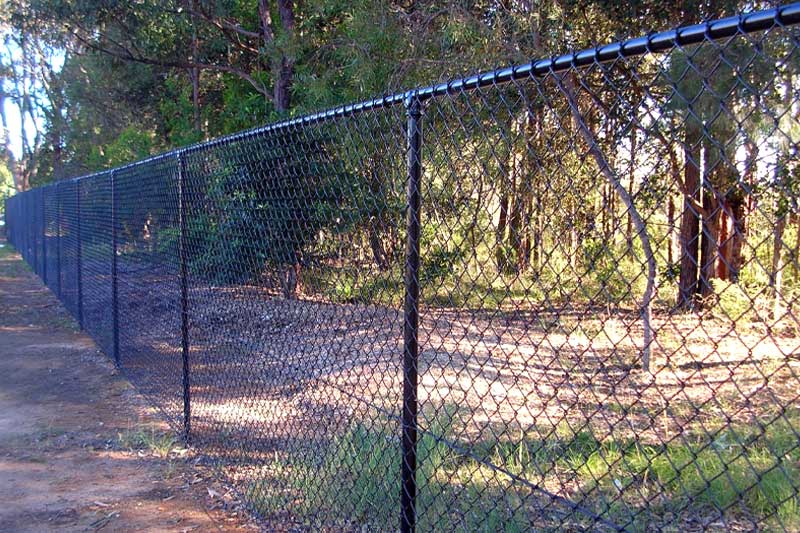
Barbed wire fence
- Made of steel and is usually used for keeping livestock and cattle contained in an area.
- Animals or people trying to pass or break through the barbed wire are repelled by the pointed barbs that can cause injury, providing effective security from predators or intruders.
- There are two types of barbed wires: livestock and security. The prices below will indicate both types.
| Description | Average Cost |
|---|---|
| Barbed Wire Fence per foot (Livestock) | $1.25 to $3.50 per foot |
| Barbed Wire Fence per foot (Security/Razor) | $1 to $3 per foot |
| Barbed Wire (Construction) 5 strands 12-gauge For a 1,300-foot fence | $1,900 |

Chicken wire fence
- Flexible, strong, and durable
- While the chicken wire is commonly used to secure poultry, this type of fencing can also keep rabbits, mice, squirrels, and other small animals. They can also be used to reinforce concrete.
- The average cost to install a chicken wire fence could run from $2 to $4.50 per foot.
Hog wire fence
- Hog wire fences are used for containing hogs and creating pens; however, they are also used for residential purposes.
- Usually, hog wires are framed with wood and are attached to wooden fences for an aesthetic appeal in residential yards.
- To install a hog wire fence, you can expect to spend about $0.75 to $3.25 per foot.
Woven wire fence
- Also called “page wire” or “sheep fencing”, are wire nets of lightweight intersecting horizontal wires and vertical wires, and are normally stretched between stakes.
- This type of fencing is commonly used for keeping sheep, goats, and pigs.
- To improve its effectiveness, people can add one or two strands of barbed wire at the top.
| Description | Average Cost |
|---|---|
| Woven Wire Fence | $1.48 to $1.85 per foot |
| Woven Wire Fence 100 feet long; 5 feet height 2” x 4” mesh | $180 per roll |
| Woven Wire (4ft by 300ft) 330 feet length; 4 feet height 6” by 6” mesh | $189 per roll |
Wire fence national average cost
A lot of factors can contribute to the cost to install a wire fence. Most of the time, people can expect a national average cost range of $2,400 to have a wire fence installation.
However, since there are several materials to choose from where each of them can serve various purposes and quality, the price consequently varies. For reference, here are the average prices:
| Description | Average Cost |
|---|---|
| Average Range | $1,250 to $8,000 |
| Low-End Wire Fence Installation Cost | $836 |
| High-End Wire Fence Installation Cost | $12,500 |
| National Average Cost | $2,400 |
In terms of cost per foot, you can expect to spend from $1 to $8 per foot, with the cost depending on the type of wire and the height. For reference, most fences stand from 26-inches to 48-inches tall.
Wire fence post cost by material
If you want to install a new fence, the cost of the posts is usually part of the overall expense of installation. However, in cases where you only need to replace or extend the length of your fence, the price for fence posts is billed separately.
For wire fences to be secure and functional, they need to be affixed to posts and secured properly to the ground. Depending on the type of wire fence, you can choose between wood or metal posts.
On average, you can expect to pay between $20 to $60 for the fence post and its installation. This, of course, depends on the type of fence and the material that you prefer.
Wood fence posts
Some wood posts come with decorative tops and are often used in combination with mesh wire or wooden frames. They also come in various thicknesses and serve their purpose best in livestock containment.
Wood posts appear more appealing compared to metal fence posts and are more versatile and more configurable. However, one of the downsides of wood fence posts is they are more prone to rot, which may need to be periodically replaced.
If you wish to pair your wire fence with a wood post, the average cost to have it installed would be around $20 to $50 per post.
Metal posts
In selecting the type of metal post you need for your wire fence, you first need to know how strong you need your fencing to be, the purpose you want it to serve and the type of wire fencing you want to attach to it.
With metal posts, you can choose from thin rods to more thick and solid pieces. Thinner metal fence posts are usually used with lightweight fencing, and heavy and sturdy wire fencing may require its counterpart metal fence posts.
Typically, metal fence posts are more durable compared to wood, with little maintenance. However, they can be less versatile and less appealing compared to wooden posts.
If you opt for a metal fence post, the average cost would be $25 to $60 for each metal fence post.
Labor cost to install a wire fence
If you wish to hire a professional for the wire fence installation, you can expect to spend between $40 to $60 per hour, which translates to $0.92 to $5 per foot in labor costs.
Usually, a post installation takes 1 to 3 days to finish. However, the actual duration of the time is dependent on the fence’s size, the type of fence you want to get installed, and other special conditions.
Another thing to account for in the labor costs is the condition of the terrain where you want the fence to be installed. For instance, if the ground is uneven or has a slope, this will be accounted for in the re-sloping costs which could run an average of $1,300.
Most of the time, it is best to hire a professional for your wire fence installation. With their expertise, you can rest assured that your fence is properly installed and will stand for a long time.
When you hire a fencing company to install a fence on your property or land, they usually bill you according to the length of the fence or the amount of time it takes to complete the installation.
You can expect to spend between $0.40 to $1.50 per linear foot of woven wire fencing. I would steer clear of fencing companies quoting by the hour. You take on the risk if it takes longer than expected.
When you get an estimate by the linear foot, the fencing service gives you a fixed price which doesn’t change if it takes longer than expected to install the fence.
Woven wire fence average cost ranges
The cost of installing a woven wire fence can depend on the length and height of the desired fence, the size of the mesh, its quality and durability, and the other considerable costs that come with the installation.
For reference, below are the estimated average costs per acre depending on the quality of work:
| Description | Per foot | Average cost per acre |
|---|---|---|
| Low-end Average Cost | $0.40 | $334 per acre |
| Mid-end Average Cost | $0.95 | $794 per acre |
| High-end Average Cost | $1.50 | $1,250 per acre |
Woven wire fencing cost per foot
When getting a quote for a woven wire fence installation, the final estimated cost should take into account the materials, the labor cost, and the size of the project.
Be sure they stipulate all of the above on their written quote so there are no surprises when it comes time to pay.
The average cost for a woven wire fence is $0.40 to $1.50 per foot. Depending on your city, costs including quality materials and installation can go as high as $2.50 per linear foot.
Considering the mesh variations, a woven wire with a 2-inch by 4-inch if you want to safeguard hoofed animals since it can be difficult for them to pass through the holes. A 6-inch by 6-inch mesh can be suitable for larger animals.
Woven wire fence cost per hour
Remember, If your hire a professional fencer by the hour, you take on the risk. They can go slow to increase the bill.
The cost to have a contractor to install a woven wire fence can typically cost between $40 to $60 per hour. Since most contractors can finish a fencing project in 1 to 3 days, the total cost can be rounded up to $320 to $1,440.
This price can vary depending on the size of their crew and the tools they have. If they are a two-man crew, and everything is done by hand, it will take longer, but be cheaper b the hour. Bigger crews will charge more per hour but may take half the time.
Woven wire fence labor cost
Typically, the labor cost to install a woven wire fence would range between $0.92 to $5 per linear foot. This, of course, depends on the specific type of woven wire fence, the terrain, and the project’s total size.
An additional factor to consider in the labor costs is the condition of the terrain. Normally, if the target area is uneven, the hired professional must “re-slope” it. This would consequently add to the time and labor considerations.
The average cost for a re-sloping would be $1,300. If you wish to have an area to install a woven wire fence and the ground has a significant slope or is inaccessible, you may have to pay for this additional cost.
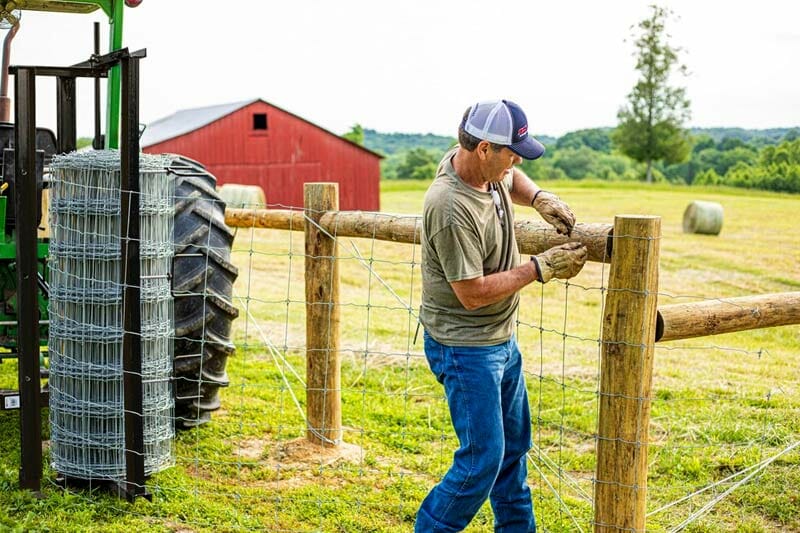
Woven wire fence other costs
Fence
- The cost of a woven wire fence could differ depending on the mesh, the length, the height of the fence, and the quality.
- Considering all the factors that could affect the costs mentioned above. The average rate could fall between $0.40 to $1.50 per linear foot.
- In other areas and other variations of woven wire fences, the average price range could be from $1.50 to $5.90.
Fence posts
- Depending on the material, height, and thickness, the cost of fence posts could vary. Usually, the most common choice for posts is metal and wooden posts.
- Generally, wood posts are more affordable, averaging from $20 to $50 each. While it may be affordable for most, the downside is they are less durable and may require replacement periodically.
- Metal posts are more durable and can offer more visual appeal compared to wood fence posts. Metal fence posts could cost up to $25 to $60 each.
Gates
- At a minimum, you should have one gate to access your fenced property. However, some property owners prefer to have multiple entrances/exits for additional accessibility.
- Typically, gates can cost you $150 to $600, depending on their material, height, and decorative aspects.
Miscellaneous
- There can be several other materials that you’ll need to successfully have your fencing project done successfully. This depends on how you specifically want your fence to be done.
- Other costs such as staples and nails to attach to fence posts can come necessary, and this could cost around $20 to $50 on average.
- Other materials including concrete can also come necessary to add a good foundation to your fence posts. Cement would cost around $3 to $6 per bag.
Factors considered in woven wire fence cost
Preparation
- Regardless of the location of your desired area to install a fence, initial preparation must be done before the project takes place.
- Initial preparations can include but are not limited to registration of a permit or property grading.
Permits to secure
- Usually, different locales or municipalities would require property owners to secure a permit before installing upgrades such as fences. These permits will assure are in line with building codes and laws.
- Generally speaking, securing permits could cost $25 to $50. However, this estimate can balloon depending on your area. To determine the actual cost, you can contact your local zoning office.
- Avoiding obtaining a permit can cost you hundreds more than securing one.
Materials
The final expense of the woven wire fencing installation can be heavily dependent on the materials and their quality.
Land grading
- Most of the time, property owners have to deal with terrain that’s not level. Having uneven ground can make the fencing more difficult and taxing.
- Depending on the required leveling of terrain, re-sloping projects can cost between $500 to $5,000.
Height and length
- Usually, woven wire fences are sold in rolls, with lengths of 100 to 330 feet per roll. These can be purchased at local hardware stores.
- The height of these fences has 4, 6, and 8-feet variations. Each for their specific purposes.
Material strength
- The material strength of a woven wire can be measured by the gauge of its wire. Typically, 18-gauge wires are the thinnest, and the strongest wires are 6-gauge wires.
- Usually, property owners can have effectively woven wire fences with 18 to 12.5-gauge wires.
Mesh size
- If you want your woven wire fence to keep livestock from going in and out, you’d want a 2 by 4-inch mesh.
- If you want to install a woven wire fence for residential purposes, a 6 by 6-inch mesh can be ideal.
- Depending on the purposes you want your woven wire fence to serve, various mesh types can cater to your needs. Their prices, of course, can also vary.
A redwood fence is celebrated for its innate allure. Crafted from a robust wood variety, it stands to reason that it would also be enduring. Yet, one may wonder, what is the typical lifespan of such a fence?
Redwood fencing can last up to 25 years with little to no maintenance. It can easily last up to over 30 years with proper maintenance.
Here is everything that you need to know about redwood fences and their longevity.
Why does redwood fencing last so long?
It lasts so long because it has tannins, acids, and other natural oils that help to protect it. It is also highly dense. And has a unique cell structure.
All of these things combine to help to shield it from:
- Moisture infiltration
- Termite and pest damage
- Warping and splitting due to temperature changes
- Physical damage
Since these are the main causes of damage for almost any wood fence, the fact that redwood has natural protection against them usually goes a long way toward guaranteeing a long lifespan.
How do you prolong the lifespan of your redwood fence?
You can easily get over 2 decades’ worth of value from a redwood fence with little to no maintenance. However, if you want to get a wooden fence to last longer, there are a few things that you should do.
Clean it
Dirt and debris don’t just ruin the beautiful appearance of redwood. They can also trap moisture. This then leads to extended moisture exposure. With time, this will accelerate the rate at which the fence wears out.
To prolong the lifespan of your fence, and almost any other wood fence, you will need to clean the fence regularly.
You should:
- Use a putty knife to remove debris from seams, gaps, and corners.
- Use a leaf blower to remove any remaining debris.
- Wash the fence with soap and water.
To remove any stubborn stains, mildew, or grease, you may have to use diluted bleach, a TSP mixture, or a specialized wood cleaner. Using a brush, instead of a cloth, may also help to remove stubborn stains.
Repair it
Dents, cracks, missing fasteners, and rusting nails are just a few of the problems that will develop over time. You should fix them as soon as they show up. Failing to do so immediately can cause the problem to spread.
Therefore, you should replace any missing fasteners as soon as possible. Reinforce loose or leaning boards. And remove rusted nails.
Stain it
A good quality stain will protect the wood from moisture infiltration. And if you use a transparent stain, you can give the redwood extra protection without necessarily having to compromise its appearance.
You can also give it better protection by applying a semi-transparent stain. Such a stain will not only shield it from moisture infiltration, but also protect it from the damaging effects of UV rays.
The added protection that the fence will get from a high-quality stain will have a significant effect on its lifespan. However, you will have to re-stain the fence after every couple of years so as to guarantee the effectiveness of this extra protection.
Create separation
If you have vines or shrubs growing next to your fence, you should trim them. Doing so is important as this vegetation tends to:
- scratch off the protective layer of the fence — be it a stain or paint
- trap moisture, and this constantly exposes the fence to moisture
- attract pests and other harmful animals that may cause physical damage
- ruin the appearance of the fence by depositing leaves and other debris on the fence
Since vines, shrubs, and plants that grow next to your fence can damage it, regular trimming can effectively prolong your fence’s lifespan.
Does redwood need to be treated?
No, redwood doesn’t need to be treated.
It can last for up to 25 years without treatment because of its tannins, oils, and unique cell structure. A combination of these factors makes it natural:
- resistant to rotting
- resistant to termite infestations
- good at handling moisture exposure
- fire resistant, and
- resistant to warping, splitting, and bulging
However, this does not mean that treating redwood is pointless.
While it may not be beneficial to treat it against termites, staining and sealing redwood will significantly improve its lifespan. It will arm the fence with extra layers of protection against the sun and moisture, and this will definitely go a long way toward increasing its longevity.
Does redwood last longer than cedar?
Yes, redwood lasts longer than cedar.
It is denser. It has stronger concentrations of tannins and oils. And it has a superior cell structure that gives it better protection against moisture infiltration, termite attacks, rotting agents, and fire.
Therefore, redwood fencing tends to last longer than cedar fences.
Is redwood good for fencing?
Yes, redwood is good for fencing.
It contains acids and natural oils that shield it from moisture infiltration. These oils and acids also repel termites and other pests.
Benefits of using it for fencing
These qualities make it a great fencing material because it means that the fence will be able to withstand the harsh external environment. The fence will be:
- less likely to become warped
- naturally resistant to termites and other harmful pests
- naturally resistant to rotting agents
- last really long
No need for regular maintenance
And since the fence will have these qualities naturally, a homeowner won’t have to worry about regular maintenance.
All these things combine to make redwood one of the best fencing materials in the market. This is so especially when you consider the fact that it isn’t treated with chemicals – like pressure treated wood.
The only downside to using redwood is that it isn’t as readily available as other fencing options like cedar. And so unless you live on the Northern California Coast, you are likely to have a hard time getting your hands on it.
It is also relatively more expensive. This usually limits its use. And it can make using it uneconomical, especially when you compare it to the cost of typical wooden fences..
FAQ's
Yes, redwood lasts longer than cedar fences.
Why?
Because redwood, from giant redwood trees, is denser than cedar. It also has a higher concentration of acids and natural oils that give it a healthy measure of resistance against rotting, pests, fire, and moisture infiltration.
No, a redwood fence does not need to be sealed.
Structure, density, and oils
Thanks to its unique cell structure, density, and protective oils, the fence has an elaborate protective system that does what a sealer normally does. Therefore, when compared to the average wood fence, it is better at withstanding moisture, sun, and extreme temperature exposure without getting damaged.
However, this does not mean that you shouldn’t seal your redwood fence.
Sealing helps
While it doesn’t need it, it can definitely benefit from being sealed. This is because the sealer will be an extra layer of protection that the harmful elements will have to get through before they can come in contact with the wood.
Therefore, sealing will help to increase the lifespan of the redwood fence.
You stain your fence at least once every 3 years. Staining it as often as after every 2 years is ok. And so is taking 4 years in-between stains.
You have to re-stain periodically because the stain wears off with time. And so if you used a stain to enhance the color of lighter redwood timber fence planks, the color may start to fade with time. And so re-staining may be necessary to enhance its appeal.
The stain may also get scratched and chipped. And so you will have to refresh the protective coating on a regular basis if you want to prolong the lifespan of your fence.
No, you shouldn’t paint your redwood fence.
Covers the attractiveness
While there is nothing wrong with painting it, you shouldn’t do it because you will be messing with one of the redwood’s best features: its beauty and appearance.
Unlike a typical wooden fence, a redwood fence has an excessively attractive reddish color. It also has a beautiful grain profile. And it always gives a home a beautiful natural appeal.
Painting it will mean covering all this behind a coat of paint. It almost makes using redwood pointless.
Naturally has what paint provides
Furthermore, the redwood fence doesn’t really need what painting provides. It is already aesthetically pleasing. And it is naturally resistant to moisture and other weather elements.
Better alternatives
There is also the fact that you have superior options like sealing and staining. These options give the redwood fence all the protective benefits of painting without hiding its beauty. This is because there are transparent and semitransparent stains and sealants.
Yes, you can use redwood as fence posts.
It is strong, durable, moisture-resistant, and pest-repellent. This means that, unlike other fencing materials like pressure treated wood, cedar, and douglas fir, it won’t have trouble bearing the weight of the fence. It also won’t succumb to moisture, rotting, and termite attacks.
You should choose cedar for fencing.
Redwood is superior
You should choose it even though redwood is superior in terms of raw strength, stability, resistance to moisture, ability to repel pests, and aesthetic appeal.
But…
Why? Because cedar is more readily available. When compared to redwood, it is very affordable. And since it has enough of the good qualities of redwood, cedar wood fences typically provide better value for money.
Yes, staining makes a wooden fence last longer. This is because a stain essentially seals the wood fibers and makes it less likely to allow moisture to infiltrate it. And in cases where one is using a transparent stain, he or she will get more out of the fence because the stain will shield it from

If you need help installing or fixing a fence, you should use HomeGardenGuides.com. The site offers a free service that allows you to easily explore and rate the quality of services that fencing experts in your area provide.
The service that they provide quickly matches you with the top-voted local expert fence repair services.
Using the website, you can get 3 estimates fast by real certified experts in your area in just 2 minutes.
Here is how it works.
- You scroll to the top of the page and enter your Zip code.
- Answer questions about your fencing needs and preferences
- Your details will be forwarded to three local experts.
- You will then receive a price estimate – in writing – for the job and some friendly advice.
IMPORTANT: There is no obligation to hire. This is a free tool and service to be used at your pleasure, whether you just need more information on fixing a fence or you need an expert’s advice.

Black aluminum fencing adds a classic allure when it surrounds a home or pool area. Although their security level might not be very high, they certainly enhance the visual appeal.
The cost of a black aluminum fence ranges from $3,111 to $6,753. Aluminum fencing is affordable, durable, and demands little upkeep. It requires an average cost of $4,932 covering the purchase and labor for the installation of a black aluminum fence.
Black aluminum fence price per linear foot
Depending on a lot of factors, the professional cost of installing a black aluminum fence could range from $19 per linear foot for plain aluminum panels to $76 per linear foot for the high-end custom-styled panel. This gives an average of about $48 per linear foot.
Black aluminum fence cost by type
Depending on the type and purpose for which the fencing is intended, the cost per foot of aluminum fencing is highlighted in the table below.
| Black aluminum fencing type | Cost per ft. (materials only) |
|---|---|
| Powder-Coated Fence | $13 - $45 |
| Pool Fence | $15 - $25 |
| Ornamental Fence | $15 - $55 |
| Picket Fence | $15 - $75 |
| Privacy Fence | $24 - $32 |
| Black Aluminum Fence | $24 - $32 |
Black aluminum fence price by quality of panels
The average cost of aluminum fencing (materials and labor) for an average aluminum panel is shown in the table below:
| Fence Type | Cost per Linear foot | Cost of materials | Installation cost | Total project cost |
|---|---|---|---|---|
| Standard | $22 - $25 | $2,992 - $3,400 | $616 - $700 | $3,608 - $4,100 |
| Average | $25 - $28 | $3,400 - $3,808 | $700 - $784 | $4,100 - $4,592 |
| Top-quality | $28 - $32 | $3,808 - $4,352 | $784 - $896 | $4,592 - $5,248 |
Black aluminum fence cost by style
The cost of an aluminum fence also varies based on style. Ranging from $50 to $75 per panel, you can choose your desired style based on your budget and other considerable factors.
The spear top and staggered spear top are top-notch in terms of security. The two-rail and three-rail flat-top designs are good for safety because it allows nothing to slip between the slats. The arch design is majorly fit for ornamental purposes.
Here’s a table that shows the cost of the various styles of fencing.
| Aluminum fencing style | Cost per panel (materials only) |
|---|---|
| Single Rail | $50 - $70 |
| Spear Top | $65 - $65 |
| Staggered Spear Top | $65 - $70 |
| Two-Rail Flat Top | $65 - $70 |
| Three-Rail Flat Top | $70 - $75 |
| Arches | $70 - $75 |
Labor cost of aluminum fence installation
Labor activities required during aluminum fencing include on-site setup, site preparation, job completion, trash removal, and work area cleanup.
The cost of labor for black aluminum fence installation ranges from $40 per hour to $118 per hour. A fencing activity taking an average of 12.5 hrs to complete will cost about $500 on the low end and $1,480 on the high end.
The differences in labor costs are due to variations like workload, job location, and seasonal wage rates.
Black aluminum gate cost
Aluminum gates usually come with elaborate designs. The accessories needed for these designs are usually more expensive than the panels.
The cost of a single gate for walkways ranges between $250 and $750. Double gates for driveways can range between $400 to $12,000. The cost depends on a lot of factors such as height, size, designs, quality thickness, and gate accessories.
Factors that determine the cost of black aluminum fence
Fence height
Residential fences have heights ranging from 2.5’ to 6’ while commercial feces can be up to 10’. The height of your fence will determine the cost of the panel to be used. The higher the height, the more the price
The thickness of the aluminum material
The thickness of aluminum fencing varies based on the intended use. Commercial and industrial fencing has thicker gauges of aluminum compared to residential fencing. Hence the higher cost of commercial fencing.
Linear feet of fence required
The commonly available widths of aluminum fencing are 4’, 6’, and 8’. The cost of your aluminum fencing will depend on the linear feet of fencing you want to do as well as the width you’re using.
Color of the fencing
The cost of aluminum fencing also depends on the color. The most affordable fencing is black. Using other colors such as beige, white, ivory, green, brown, tan, sandstone, and gray requires that you pay a higher premium price.
Posts and caps
Posts and caps used in the fencing are produced in various styles with sizes ranging from about 2” square to 6” square. They are also differently styled. The size and design of posts and capos will also determine their cost implication in the overall estimate.
Knowing the length of the fence, the width of the panels, and the number of corners, you can determine the number and types of posts required for the fence.
Other decorative features
There are different types of decorations applicable to aluminum fencing depending on your specification and budget. Some of them are brick column separators, scalloped or shaped posts, and gates of all shapes and sizes. T
The more decorative and creative you want the aluminum fence to be, the higher the cost.
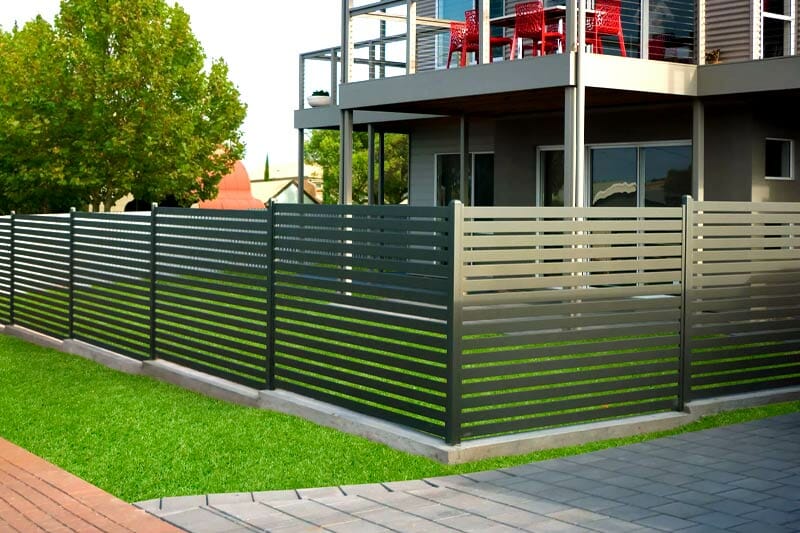
Benefits of black aluminum fences
- Compared to iron and steel fences, aluminum fences are mostly preferred due to their low cost of maintenance.
- Aluminum fences don’t require painting like wooden fences and they don’t rust like iron fences.
- With a hose and a few gallons of water needed to rinse off any possible blemish, the aluminum fence is easy to clean and hence the low cost of maintenance.
- Due to the possibility of painting in different colors, aluminum fences fit perfectly into any home aesthetic.
- Aluminum fencing components are easily recycled once they’re out of commission.
Black aluminum fence installation
There are two options to consider in installing your aluminum fencing:
DIY installation
With some technical know-how and in the presence of the right materials, you can decide to go with a DIY installation. Materials needed are posts, pre-assembled aluminum fence panels, and ornamental accessories.
Hiring a fence company
You can as well hire professional fencing companies to install your new aluminum fencing. We’ll connect you with the 3 best companies that will install your fencing at the best prices if you fill out the form above.
The cost of professional installation covers permits and a site survey to locate property lines. All labor and aluminum fencing materials to install the fence, concrete for anchoring the posts, and all cleanup after the fence installation will form part of the cost.
Black aluminum fence DIY installation guide

Preliminary steps
- Discuss your fencing plans with your neighbors in case their property lies along your proposed fence line. They may end up splitting the cost with you.
- Make sure every part of your fence is on your property.
- Check for easements in your deed. An easement is a right of way granted to another property owner or utility company, which may limit the design and location of your fence.
- Check local zoning laws, which may determine the size and placement of your fence.
- Discuss your plans with your neighborhood association before proceeding with your fencing.
- Before any excavation, call 811 so you can stay off of underground utilities.
Drilling the posts
The posts are drilled for placement at the right points.
(Hint: End posts have holes on only one side and are used as starting and stopping points. Corner posts have holes on adjacent sides and are used to make right angles. Line posts have holes on opposite sides and are used for straight runs for fences. Gate posts are similar to end posts but are stronger in order to support the weight and movement of the gate).
Aluminum fence layout
Take time to lay out the fence carefully with accurate measurements. Aluminum fencing works fine with gentle dips in the land. This means if you’re planning to install your fence in a sloppy area, you may need to go with another fencing type.
Here’s how to plan your fence layout:
- Stake out your fence line from beginning to end. This should include corners and gates.
- Tie a string taut between the corner post locations. It will help you define the line along which the line posts should be placed.
- Use the measurements provided by the fence manufacturer to mark out the line post locations.
- Take any gates or openings into account while marking out the line post.
Digging the holes for fence posts
- The underground task of digging the holes where you’ll place your fence is the most important task in fencing. You can achieve this using a digger.
- Following the manufacturer’s recommendation, dig the holes with the appropriate depth and diameter.
- Dig the hole in a bell shape, with the bottom wider than the top. This will help to stabilize the post.
- Backfill each hole with about 6 inches of gravel to drain water that may likely be present at the bottom of the post.
Installing the fence
- Set the poles in the holes. Remember to use the appropriate post for each point on the fencing line.
- Fasten the fence panels between the posts.
- Ensure you follow the recommendations provided by the manufacturer.
Finding a good black aluminum fencing contractor
With the flood of self-acclaimed professionals in the market, it may be difficult to get the perfect man for the job.
When you’re confused about getting a good contractor for your aluminum fencing job, follow these recommended steps:
- Ask around from your neighbors, friends, and families who have done such fencing in the past to recommend a trusted professional.
- Get multiple estimates from professional contractors
- Verify the warranty
- Confirm their experience.
Use this FREE service
HomeGardenGuides.com matches you with the 3 fencing professionals voted #1 by previous users in your area.
- Scroll up to the top of the page and enter your ZIP Code in the blue form at the top of the page.
- Give us a few details about your fencing job plus some contact information.
- Your fencing details are forwarded on to the closest three fencing contractors all voted best priced who will also price your fencing job.

How to maintain black aluminum fences
- Black aluminum fences are almost maintenance-free.
- Thorough cleaning with water once a year is usually recommended by the manufacturers.
- Additional maintenance which may be required after long years may include tightening of the fasteners and concrete of the underground holes.
How long does black aluminum fence last?
An aluminum fence generally remains intact for more than three decades. Meanwhile, it has the potential to last far longer under favorable conditions. Its longevity will vary depending on several factors. Some of these factors are:
Cleaning
Since there’s no risk of rusting, cleaning aluminum fences to get rid of external agents such as dust and algae will protect the material and make it last longer.
Proximity of trees
The close location of aluminum fencing to trees will negatively affect its lifespan. Tree roots or limbs can cause major damage when they come in contact with the fencing.
Location
The location of fences has a direct impact on their lifespan. Aluminum fences located in high-activity areas such as a parking area will likely have a short lifespan. (Even bollards, in commercial spaces have this problem.)
The risk of car accidents and collisions will be accountable for this. Lightening your face area can help to mitigate this risk.
Weather
In areas where there is a high occurrence of wind, storms, and other disasters, the longevity of such fencing cannot be guaranteed. This is due to unforeseen accidents that may occur from time to time.
Aluminum vs steel vs iron fence
Aluminum, steel, and wrought iron are the most common fencing materials. Your choice of the appropriate fencing materials depends largely on budget, durability, and a lot of other factors.
The table below shows the comparative features of the three fencing types. It’s a guide to follow when you need to make a choice.
| Aluminum Fencing | Steel Fencing | Iron fencing | |
|---|---|---|---|
| Installation cost | Low | Very High | High |
| Styling options | Numerous | Limited | Numerous |
| Cost of maintenance | No | Low | High |
| Cost of maintenance | No | Low | High |
| Pros | Affordable Easy to install Highly customizable | Very Durable Secure Resistant to corrosion | Can be styled into classic ornamental forms |
| Cons | Not suitable for privacy | Limited styling options | Difficult to install Prone to rust Requires frequent painting |
Bottom line
Black aluminum fencing is a promising fencing option. Its affordable cost of installation and maintenance makes it budget-friendly. Durability, ease of installation, and resistance to damage are other great advantages that make aluminum fences more acceptable to a large number of people.
If you’re wondering about the cost and process of installing your black aluminum fence, this guide is what you need.
Homeowners looking to enhance their home’s privacy will discover that installing a Redwood fence is an excellent choice. The installation price of such a fence depends on the selected design, dimensions, placement, and desired finishing.
On average, installing a redwood fence costs between $15 to $40 per linear foot, fully installed. At minimum, you can spend about $8 per linear foot to install the fence, while the maximum cost can be up to $60 for privacy fences. Materials alone can cost around $7 to $25 per linear foot.
Here is a table showing the average cost of redwood fence installation cost per linear foot.
| Size (Linear Foot) | Average Cost (Materials only) | Average Cost (installed) |
|---|---|---|
| 25 Linear Feet | $125 - $375 | $375 - $875 |
| 50 Linear Feet | $225 - $750 | $700 - $1,700 |
| 100 Linear Feet | $450 - $1,450 | $1,450 - $3,500 |
| 200 Linear Feet | $950 - $2,950 | $2,950 - $7,000 |
| 500 Linear Feet | $2,550 - $7,800 | $7,800 - $17,000 |
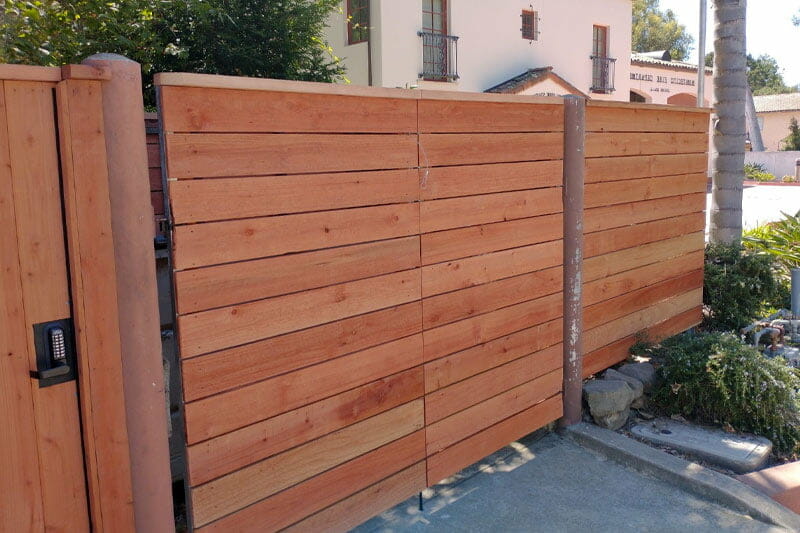
Redwood Fence Installation Labor Cost
Professional fence contractors charge an average of $8 to $25 per linear foot for labor to install a redwood fence. The costs may vary depending on your location. Typically, people living in high-income areas (urban settings) may get higher labor quotes than people living in low-income areas.
Redwood Fence Cost by Style
There are several options you can choose from when installing your redwood fence. The overall cost of a redwood fence will depend on the type of fencing you choose. Ranch style and picket are on the cheaper end of the spectrum, with an average cost of around $10 to $15, installed.
Privacy fences, on the other hand, can cost up to $27 to $60, which is quite expensive because it requires more materials and time.
Below are various options you can consider when installing a redwood fence:
| Style | Cost Per Linear Foot (Materials Only) | Cost Per Linear Foot (Installed) |
|---|---|---|
| Horizontal | $5 - $12 | $15 - $22 |
| Privacy Fence | $10 - $17 | $27 - $60 |
| Wooden Picket | $3 - $8 | $10 - $18 |
| Picture Frame Louvered Frame | $7 - $12 | $17 - $27 |
| Picture Frame Board-on-Board | $5 - $10 | $15 - $25 |
| Piano Key Lattice Fence | $7 - $11 | $18 - $24 |
| Shadow-box Fence | $7 - $15 | $17 - $35 |
| Nail-on Flat Fence | $3 - $5 | $10 - $15 |
| Ranch Style/ Split Rail Fence | $3 - $6 | $8 - $16 |
| Stockade Fence | $5 - $10 | $15 - $20 |
Is It Cheaper To Build a Horizontal or Vertical Redwood Fence?
Ideally, horizontal redwood fences cost more to install than vertical fences. This is because the boards used should be from high-grade lumber to prevent sagging. However, horizontal fences may still sag over time, but they can still last for several years without needing a replacement.
How Long Does a Redwood Fence Last?
With proper care and maintenance, redwood fences can last for about 15 to 25 years. The lumber is naturally resistant to insects, rot/decay and warping, and requires little maintenance.
What Is the Best Redwood for Fencing?
When installing a redwood fence, it is recommended to use higher-grade lumber as it is the most durable, and it is more resistant to insects and decay. However, higher-grade redwood is expensive than low-grade redwood, which may make homeowners with a tight budget to look for other cheaper fencing options.
If you still want to use redwood because of its aesthetic value, but your budget is tight, you can use high-grade redwood for your panels and low-grade lumber for the fence posts.
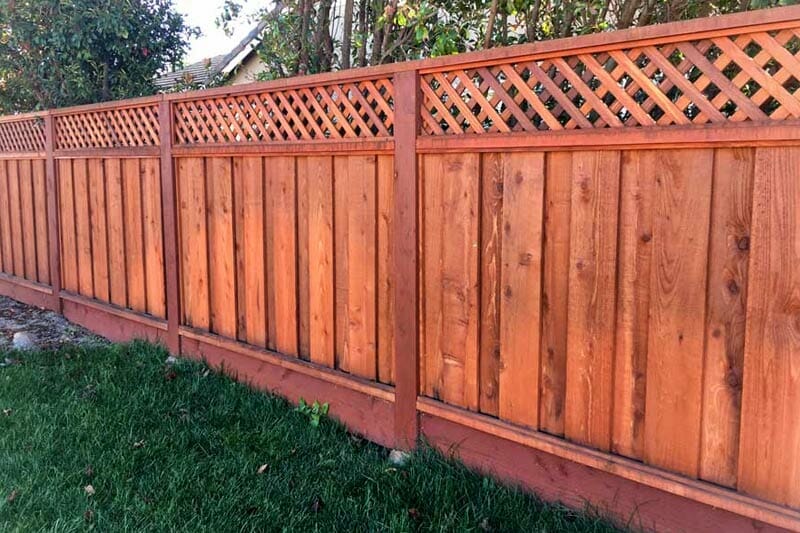
Repair and Maintenance Cost for Redwood Fence
Redwood fences require little maintenance because of their natura; resistant to insects, rot and warping. You can clean and stain the fence every 2-3 years to maintain its natural look and boost durability.
Repairing a redwood fence costs around $300 to $900. The cost can be as low as $150 for small repair jobs, while significant damage can cost up to $1,350 to repair.
Are You Ready To Hire a Redwood Fence Installer?
Finding a reliable redwood fence installer is not as challenging as most people think. As long as you do your due diligence, interview several professionals and get at least three quotes, you are good to go. However, if you do not have the time to search for a professional, we can help you.
Use this FREE Service
HomeGardenGuides.com is a free service that quickly matches you with top voted local Fence contractors.
You can get 3 estimates fast by real certified experts in your area in just 2 minutes.
- Scroll to the top of the page and enter your Zip code.
- Answer questions about your mold job
- Your roof details are forwarded to three local experts. They will send you a price estimate for the job and some friendly advice.
IMPORTANT: There is no obligation to hire. This is a free tool and service to be used at your pleasure.

FAQ's
A fence does not necessarily add value to a home, but it may enhance your home’s value if there is a true need for the fence.
Yes, it is cheaper to DIY your fence installation as you will not have to pay for labor costs which tend to take about 50% to 70% of the overall project cost.
However, DIY projects may end up being costlier in the long run because you will still need to buy all the materials and equipment needed for the installation. Besides, you may make mistakes that may cost more to repair, and you may also injure yourself if you do not have enough skills for the job.
For this reason, it is best to hire a professional fence installer to handle your project. The professional will know where to buy materials and all needed equipment at a cheaper cost. Also, the expert will complete the project in time, which is convenient if you need to use the structure for an upcoming event.
Redwood fences are durable and l;onglasting as they are resistant to rot, decacy, warping and insects. These fences are also easy to maintain, and do not require much cleaning.
Redwood is harder than cedar, so it is more long-lasting and durable. Naturally, redwood contains more naturally occurring chemicals than cedar, making it more resistant to insects, rot and decay.
Yes, redwood turns gray over time due to the effects of weather. As the weather changes, redwood becomes lighter in color, and eventually turns to a light, driftwood gray.
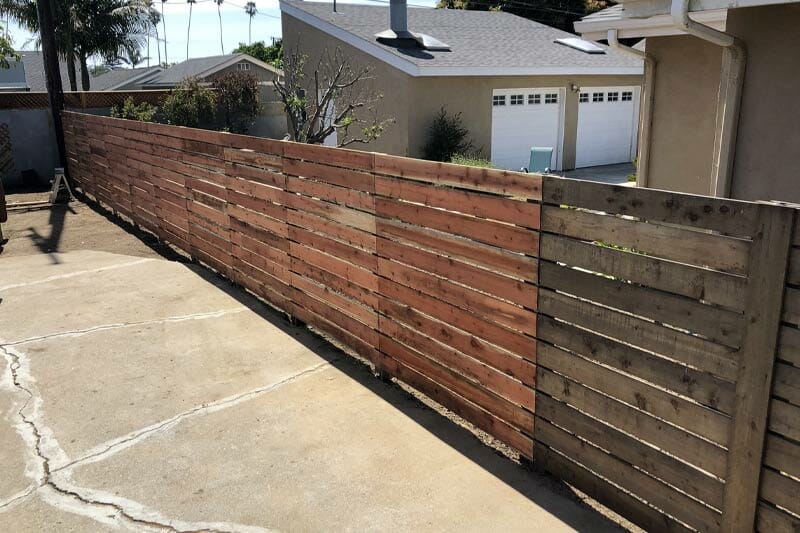
Yes, you will need a permit to build your fence. Whether it is a front, side or boundary fence, you should get a permit from local authorities before you begin the project. The permit laws and regulations may differ from one state to another. Also the fence height differs depending on where it will be located.
More and more people are choosing to use metal posts for their wood fencing because they offer better durability and stronger support for the fence.
On average, a customer will pay $4,500 for a wooden fence with metal posts. The total cost depends on the height, style, number of posts, and the shape of the posts.
The price is subject to change depending on the contractor that you use, type of metal and wood, permits, the terrain, among other factors.
Average Cost of Wood Fence with Metal Posts
To get the accurate cost of installing a wood fence with metal, you will need to involve a professional.
The cost of installation for a wood fence is $3000 – $6500, but the average customer will most likely pay $4500 for a standard-sized residential land, which is about 209 linear feet. On the low end, you can spend about $2,000 on the fence without a gate. The cost can go up to $10,000 for a 6’ high privacy fence.
| National average cost | $4,500 |
|---|---|
| Average range | $3000- $6500 |
| Low-end | $2,000 |
| High-end | $10,000 |

If you insist on getting the estimate yourself, get a pen and paper and:
- Write down your budget.
- Identify and note down the type of wood you want and is within your budget.
- Identify and write the type of metal posts you want; again, ensure it’s within budget.
- Add any additional costs, such as gates and decorations.
- Calculate the final price.
This will form the foundation of the whole project, and it will help you stay within budget and not break the bank. However, remember that this is just a rough estimate, and it may go overboard or even below budget.
Factors Affecting The Cost Of Wood Fence With Metal Posts
Various factors determine the cost of a wooden fence with metal posts.
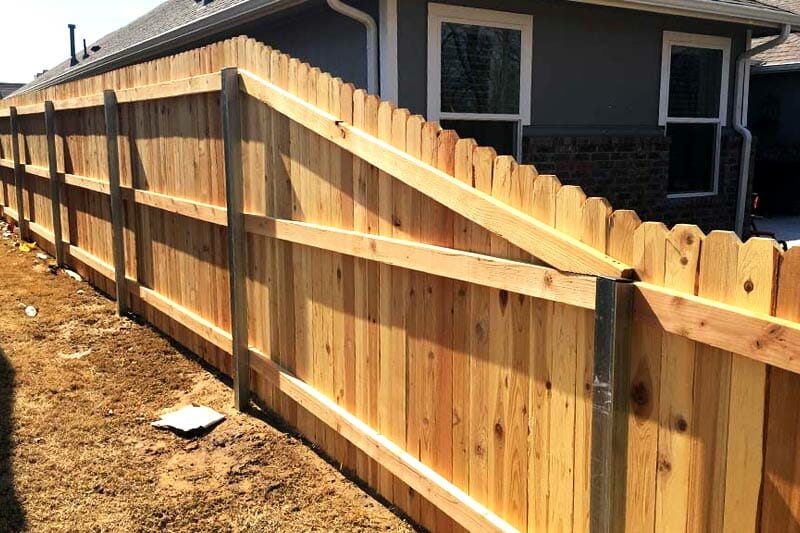
The Type of Wood
The type of wood is the primary determinant of the price. Different types of wood come in at different prices. The one you use narrows down to your budget as the homeowner and the aesthetic appeal that you are going for.
Some popular options you may explore include:
| WOOD TYPE | COST | BENEFITS |
|---|---|---|
| Western redceda | $6 to $8 per six feet picket | Resistant to rot, moisture, and weather damage resistant |
| Redwood | $8 for six feet picket | A mid-priced option that needs to be stained before installation to preserve its beauty |
| Spruce | $5 for a six feet picket | An economical but less durable alternative |
| Pine | $1 to $5 for a six feet picket | An affordable fencing option resistant to rot and insect infestation |
| Tropical hardwood | $10 to $15 for a six feet picket | Last a lifetime and feel like natural wood |
The Type of Metal
The price of metal posts varies depending on the metal material used, its height, and the quantity you purchase. For instance, the price difference between a wrought iron metal post, steel post, and aluminum post is significant.
Steel Posts
Steel posts are mid-priced, ranging between $30 and $60, and are often used to install wooden fences because they are robust and long-lasting. These posts will serve you well for more than two decades with little to no maintenance. You can enhance the strength and durability of steel posts through galvanization, which also boosts their rust resistance properties.
Aluminum plated posts
Aluminum plated posts are also a popular option that ensures you save a few coins. They cost $25 – $45 and are perfect for experimental designs since they are more versatile than steel posts.
Metal posts
Metal posts can cost between $3 and $50 each. The cost is also based on the style of the posts. For instance, you pay less for slim metal stakes than you would for round poles or sturdy square metal posts. Corner and gate posts are also significantly more expensive ($50-$150) than line posts.
The Fence Contractor
Although you can install a wood fence with metal posts yourself, making use of professional contractors is always the best option because these contractors are skilled and more conversant with fencing jobs.
Most contractors charge between $40 and $150 to install the metal posts. That’s because most fencing contractors only install vinyl or wood posts as part of a complete fence installation project.
The total cost of installing each post will depend on the size and depth of the post hole and the material used to anchor the post, whether concrete or gravel. Anchoring using concrete boosts the price by $2-$4 per linear foot more than gravel.
Permits
As aforesaid, a contractor is vital in this process because they should know whether or not local building codes require permits during the construction of a fence and what restrictions are present.
If you do not want to incur the cost and hustle of building your dream fence, then have to bring it down because you did not abide by the restrictions or secure a permit.
On average, the cost for a permit ranges from $400-$800, but this is different in all states.
Nature of the Land
The nature of the land also affects the cost of installing a fence.
- Accessibility. If the land on which the fence is being built is not easily accessible, labor costs will shoot up significantly, making the overall cost of the project increase. This is because you have to incur the cost to transport employees and materials.
- Hindrances. If the land has shallow groundwater, clay, rocks, and bushes, just to mention a few hindrances that will require preparing the ground, these obstructions increase labor costs by 20% to 40%. That’s because prepping the land will take more time than it would if there were no hindrances.
- Slope. If the land is on a slope, the cost will increase drastically. Working on a slope is cumbersome and may require additional materials to ensure the fence remains strong and sturdy.
You can also opt to surface mount the metal posts using a welded flange if the land is hard. This requires additional materials that result in higher costs.
Decorative Fence Post Caps
You can add decorative post caps to the ends of the metal posts to improve the attractiveness of the fence. These can cost between $5 and $50 each.
Boost the functionality of the caps by adding lighting, which typically costs between $20 and $60 per lighted cap. Installing the lighted caps is the job of an electrician and costs about $65 to $85 per hour.
Other Cost Factors
- The cost of removing and disposing of existing fencing is excluded from the average price and costs about $2 and $5 per linear foot.
- Gate installation is also priced separately and ranges between $200 and $600.
Why Settle For Wood Fence With Metal Posts?
Metal posts became popular after the ban of Chromated Copper Arsenate, which was used as a preservative to prevent wood posts from being exposed to moisture in the ground.
The popularity of metal posts for wood fences is well deserved owing to the multiple advantages offered by the posts.
Makes Your Fence Last Longer
The minute wood posts are embedded on the ground and are in constant contact with moisture and insects they begin to decompose. This makes the wooden fence meet its early demise due to a rotten base. On the other hand, metal posts are not subject to destruction from moisture or insects, ensuring the fence lasts long and serves you well.
Make the Fence Stronger
Regardless of the type of metal you use, metal posts are significantly stronger than wood posts. Erecting a wood fence with metal posts offers greater support to a wooden fence and makes it less vulnerable to harsh weather, which may easily bring down the fence.
Enhances Curb Appeal
There are plenty of designs to choose from as well as a handful of metal types that you can use to beautify your fence. This breaks the monotony of having a plain wood fence without outstanding designs.
The Fence Will Stand Straighter
As wood posts continue to age, individual posts begin to get weaker, and you may notice several posts in a section breaking at the base, making the fence posts lean to one side. Metal posts will not break easily or get weaker over time, meaning they will help maintain your fence’s structural integrity for longer.
Every good thing has its negative side, and metal posts are not excluded. While its positive attributes outweigh the negatives, they significantly contribute to a high price point compared to other metals.
Looking for a Quality Fence Contractor?
Different contractors charge differently for the same task. Before hiring a contractor, always ensure you do extensive research and compare several contractors before settling on one because the fence contractor is an integral part of this project.
Homegardenguides.com is a FREE tool to help you get several estimates in your area, and compare them to get the most affordable prices.

A fence that slopes is not only an eyesore but also presents a hazard. It can detract from the aesthetic appeal of your residence and compromise your privacy and security.
The average cost of repairing a leaning fence ranges between $400 and $1,100. The amount you pay will be determined by the extent of the problem but in most cases it requires replacing fence posts.
More detailed costs such as per foot and per post prices are below.
The Average Cost of Repairing a Leaning Fence
| LOWER PRICE LIMIT | HIGHER PRICE LIMIT | |
|---|---|---|
| Average leaning fence repair cost | $200 | $1,000 |
| Cost per linear foot | $100 | $50 |
| Cost to replace fence posts (per post) | $120 | $400 |
| Cost to replace fallen fence panels | $100 | $500 |
| Cost to repair holes and cracks | $100 | $400 |
| Labor costs (per hour) | $50 | $200 |
| Storm damage repair costs | $300 | $200 |
| Fence reinforcement cost | $200 | $600 |
| Gate repair cost | $100 | $400 |
| Extra cost of emergency fence repair | $100 | $200 |
On average, you can pay between $400 and $1000. The job involves repairing panels and rails and rehanging fallen panels. Typically, it’s cheaper to mend leaning fences caused by poor installation or wear and tear than it is to repair a fence that’s leaning because of rot, pest infestations, or storm damage.
You will pay less if the posts and foundation are intact and more if they fall because that calls for more effort and time.
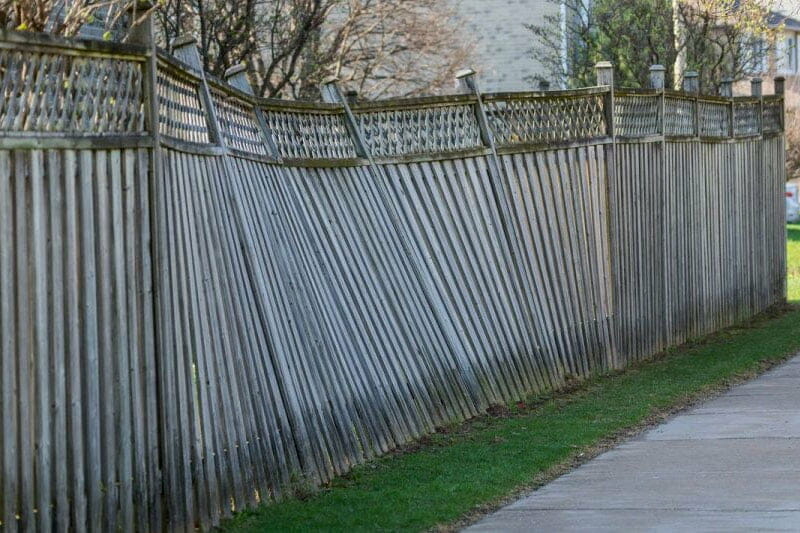
Factors That Determine the Cost of Leaning Fence Repair
Many factors determine how much you pay for your leaning fence repair. Among them:
- The cause: Knowing what is causing your fence to lean helps determine a suitable solution and determines how much you pay for the repair of your leaning fence.
- The extent of the damage: Some leaning fence repairs only require a few screws to secure and stabilize the fence, while other times, it is necessary to panels posts and hardware. The labor and materials needed for either repair will determine how much you will pay.
- The type of fence: You can expect to pay more if your leaning fence is made of expensive materials. For instance, chain link fences are cheap to purchase and repair compared to vinyl fences.
- The length: You will pay more if the damage extends far down a fence because you will have to replace multiple panels.
- The height: Taller fences require more materials and labor to fix, so you can expect to pay more if you have a fence that’s taller than the standard height.
Leaning Fence Repair Cost Per Foot
Professional leaning fence repair costs homeowners between $10 and $50 per linear foot. Unfortunately, most repair companies have a minimum call-out price while others specify charges for certain types of repairs. As a result, they do not always charge per linear foot.
The price varies depending on the fence height, location, fencing material, and extent of the damage. You can get the fence estimate when a contractor visits the worksite.
A DIY repair is often cheaper as you only incur the material cost.
Cost to Replace Fence Posts
Broken, damaged, or shifting fence posts compromise your fence’s structural integrity and cause sagging, wobbliness, or leaning.
Sometimes the leaning or wobbliness is a result of improper installation or soil disturbances. In these instances, you won’t need to replace the posts; instead, they need to be reset or be reinforced to remain sturdy and upright.
However, other times the posts become weak, shaky, and lean due to water damage, rot, or pest infestation. In these cases, you need to replace the posts to salvage your fence. Replacing the posts costs approximately $120 to $400 per post.
More often than not, you will also find it necessary to replace the posts if they are completely damaged due to collision or shifting ground. Therefore, repositioning or resetting costs significantly less than replacing the posts.
Cost of Replacing Fallen Fence Panels
When a fence starts to lean or sag, it is common for some fence sections to collapse or fall. Fallen fence sections could potentially damage the support posts for your fence and leave unsightly gaps.
If the damage is not extreme, it’s possible for your fence contractor to reposition or screw the panels back into place. However, where there’s extensive damage, the contractor may need to replace the fallen sections.
Replacing fallen sections, such as multiple panels, a section of fencing, top rails, and support posts, could cost an average of $500 and above.
The cost depends on the type of panels, material, and size. For instance, you will spend more to replace a wrought iron section of your fence than you would pay to replace a simple vinyl panel.
Cost of Repairing Fence Holes and Cracks
As we’ve mentioned already, your fence may be leaning because of installation issues. These issues could be cracks and holes at the base of the fence. The average cost of repairing these holes and cracks ranges between $150 and $350.
The actual cost is determined by the severity of the damage and the materials used for the fence base.
Posts can also crack due to heavy impact, weathering, or storm damage, causing leaning. But, again, you can cut costs by patching up or treating them with materials like mortar and resin. The price is also about $125 and $370 but could be more for wood and vinyl fences that require repainting to maintain their lustrous appearance.
Labor Cost to Repair a Leaning Fence
Professional fence contractors charge between $50 and $200 per hour. A handyman’s rates are on the lower end of the spectrum, while a fence repair expert is likely to charge more for their specialized skills and experience.
The labor costs generally depend on the extent of the damage, fencing materials, and type of repair. Therefore, chain-link, aluminum, and wood fence repairs are cheaper (about $40 to $80 per hour), and metal fences that must be welded cost about $75 to $200 an hour.
It’s common to find fence repair companies quoting a minimum fee or call-out rate of around $75 to $100, which may be waived when you hire them to repair your leaning fence.
The labor costs accrue depending on the time needed to complete the job. For instance, resetting or replacing several boards or panels is completed faster than large fence section reinforcements.
Typical leaning fence repairs take anywhere from 24 to 72 hours, depending on the length of the fence.

Storm Damage Repair Costs
Storms are a common culprit in the realm of leaning fences. If a storm damages your fence, you can expect to spend between $300 and $2,500, depending on the extent of the damage.
Major damage, characterized by entire downed sections or multiple fallen panels, is more expensive than minor damage, which may involve reinforcement, patching up, and replacing screws.
Fence Reinforcement Cost
A leaning and wobbly fence is an accident waiting to happen. Fortunately, you act now by having the flimsy fence reinforced before the worst comes to be.
The cost of reinforcing an existing fence is between $200 and $600. This cost depends on the amount of work required, the reinforcement method, and the material used for reinforcement.
The materials most commonly used to reinforce fences along the rails include aluminum, wood, vinyl, and steel. Sometimes concrete is used to strengthen and secure the base of fence posts.
Gate Repair Cost
Gates are technically part of a fence, and often damage extends to them too. For example, when the fence sections closest to your gates are leaning, it’s common to find gate hinges are damaged, and the gates themselves are damaged.
The repair needs may vary from the replacement of hinges, screws, and hinges to installing a new gate. The average gate repair costs range from $100 to $400. The price includes the replacements and resetting gate supports to prevent further sagging.
Emergency Fence Repair Cost
A leaning fence could be a looming safety threat. In some instances, when your 8-foot privacy fence leans towards a utility line, it calls for an emergency same-day repair. Many contractors offer emergency services but at an extra $100 to $200.
Over time, a wooden fence will accumulate grime, dirt, mold, mildew, and algae. It will need a good clean every 4 – 6 years to keep looking great.
There are two ways to clean your wood fence, with a power washer or by hand. A power washer is recommended as it is very fast and does a better job.
Let’s clean your fence!
No. 1: Powerwash
If you use a power washer you will finish the job quicker than washing it by hand. If you don’t have one you can rent it from your local hardware store. You must be careful because you might damage your fence. Follow these steps to make sure that you power wash your wooden fence correctly:
Step 1: Remove Dirt and Debris With a Wire Brush
Before you power washes your wood fence, take a wire brush and gently scrub off caked-on grime such as mud. It is especially important to be gentle with a painted fence because the wire brush can cause significant damage to the paint.
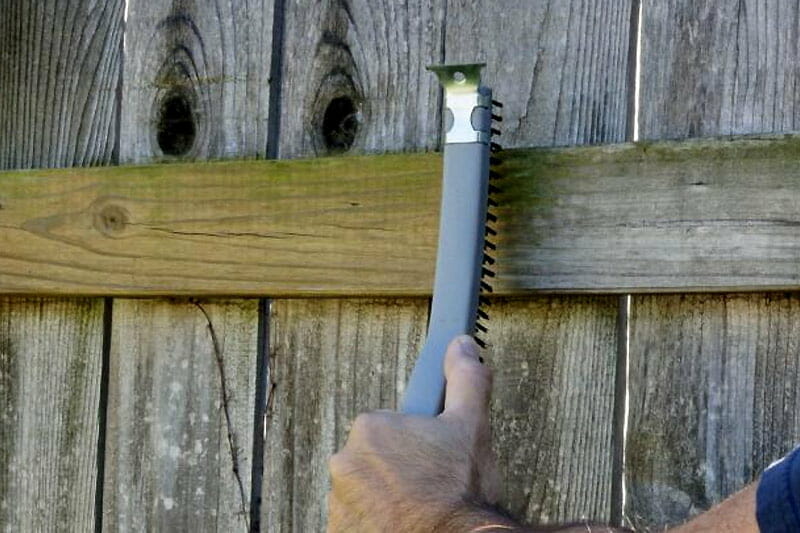
Step 2: Use a Garden Hose To Rinse Your Fence
Prepare your entire wooden fence for pressure washing using a garden hose set up on medium-high pressure to get off some surface dirt.
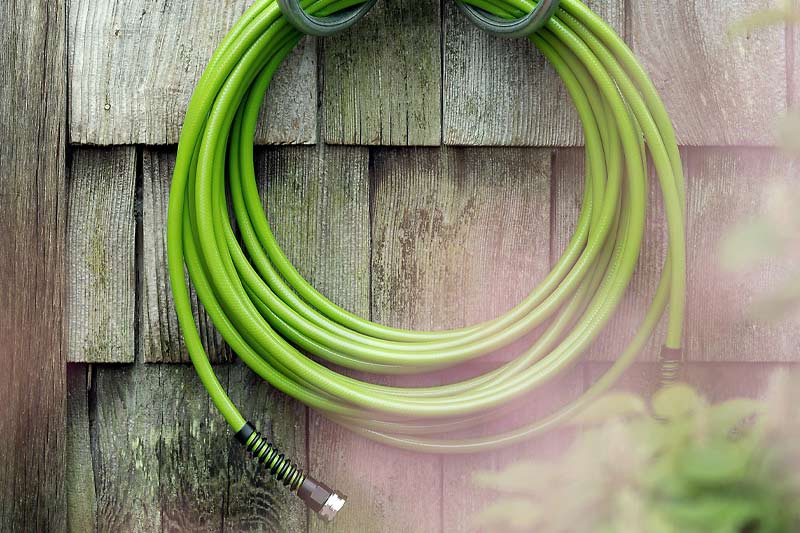
Step 3: Prepare Your Pressure Washer for Action
Be careful when pressure washing a wood fence so that you don’t damage it. Do not use higher pressure than 1500 – 2000 psi.
My recommendation is to add a tip to the pressure washer that will fan out the water, a 25-degree tip is a good choice.
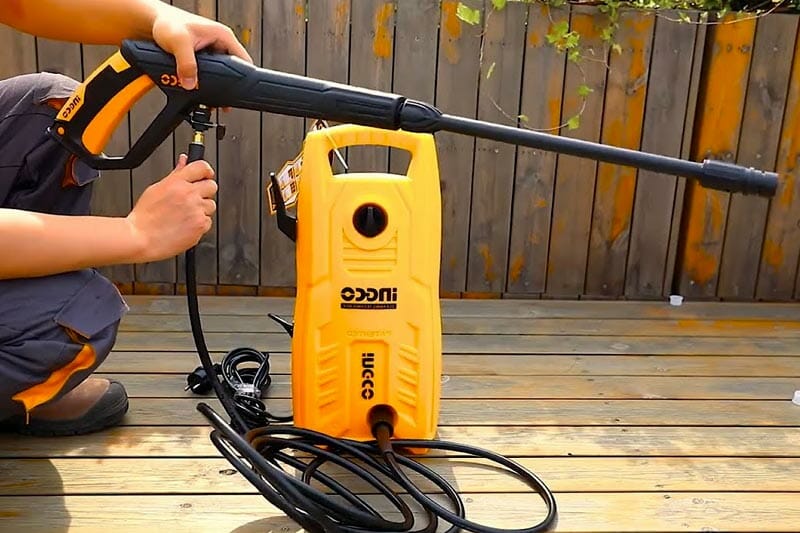
Step 4: Clean Your Wood Fence With Long and Even Strokes
Stand about 2 feet away from the fence when using a pressure washer. With long and even strokes spray from right to left and keep going until you no longer see dirty runoff coming from the fence.
Never point the power washer at one particular spot for too long because you will end up damaging your wooden fence.
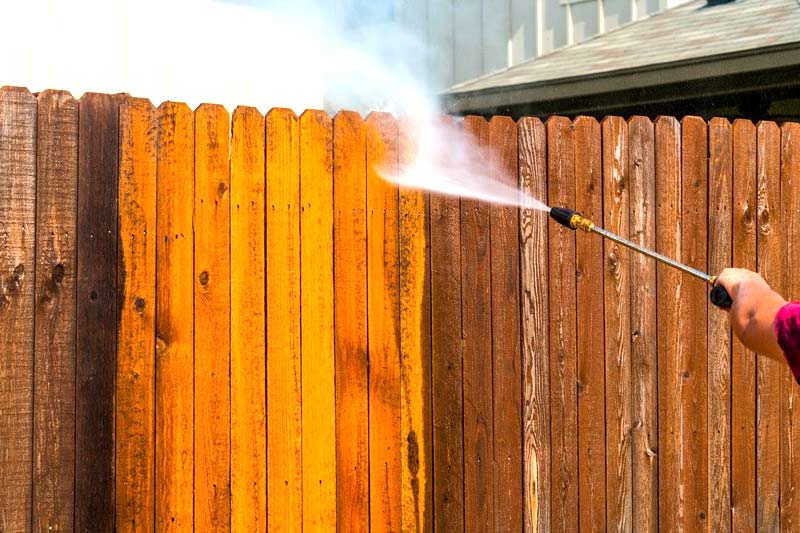
No 2: Clean Your Fence by Hand
Hand-washing your fence can take your time but it is a good option if you are concerned about potentially damaging your fence. Follow the following steps.
Step 1: Prepare Your Fence
As with the power washing method, prepare the fence first by scrubbing off caked-on bulk like mud with a metal brush and then rinse the fence with a garden hose.
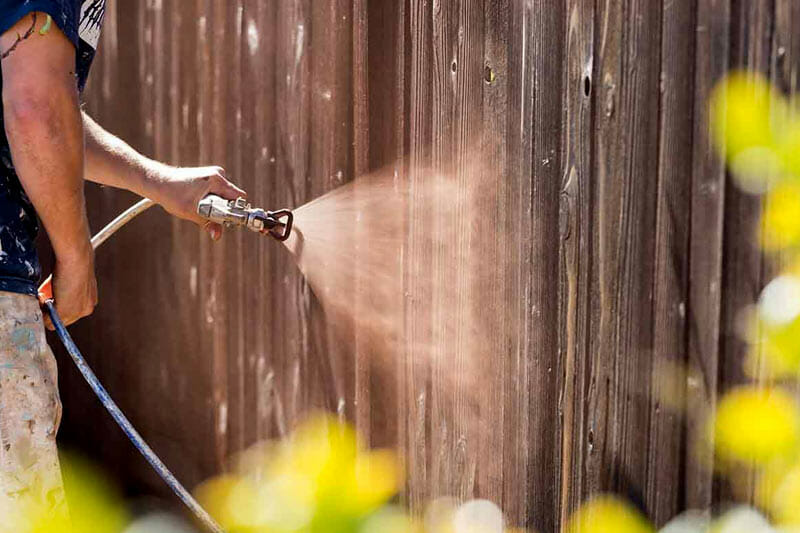
Step 2: Apply Oxygenated Bleach
Oxygenated bleach is a great tool for safely removing stains from fence and exterior surfaces.
Following the manufacturer’s instructions, mix an oxygenated bleach powder with water and then begin to brush it onto the fence using a painter’s brush. Use a large paintbrush so that you can get the job done faster. Let the bleach sit for 15 minutes.

After 15 minutes use a plastic bristle scrub brush to scrub off the dirt and rinse the bleach off your wooden fence using a garden hose.
Removing Mold, Algae, Moss, and Mildew
After washing is done you may have some mold, moss, mildew, or algae left to be clean. Here is how to remove them:
Removing Moss and Mildew
Moss and mildew are both damaging your fence. To remove moss and mildew use a mixture of ½ cup of vinegar and 1 gallon of water. Apply this mixture to the wood fence with a sponge and let it sit for 15 minutes. After that use a plastic bristle brush to scrub off the moss and mildew and rinse the whole area with a garden hose.
Removing Mold and Algae
Like moss and mildew, mold and algae can cause significant damage to your fence even if you clean them. They leave behind green stains. These ugly growths can be removed with a mixture of one part chlorine bleach and two parts water. Scrub the mold and algae from your fence using a plastic bristle brush and this mixture. This mixture will make mold and algae go up and with rinsing, you can get rid of them.
If your fence is still dirty and unsightly enough that even all the washing doesn’t help, maybe it is time for a new fence. For best offers and free estimates follow the instructions from the paragraph below:
Use This FREE Service
HomeGardenGuides.com is a free service that quickly matches you with top-voted local Fencing Specialists.
You can get 3 estimates fast by real certified experts in your area in just 2 minutes.
- Scroll to the top of the page and enter your Zip code.
- Answer questions about your fencing job
- Your fencing project details are forwarded to three local experts. They will send you a price estimate for the job and some friendly advice.
IMPORTANT: There is no obligation to hire. This is a free tool and service to be used at your pleasure.

FAQ’s
Can Mixing Cleaning Solutions Be Bad?
Yes. This is the most common when bleach and vinegar come together. If you plan to use both of them in the same procedure, be sure that the bleach is fully rinsed before you proceed with the vinegar. Mixing the two of them can cause a deadly and poisonous gas.



